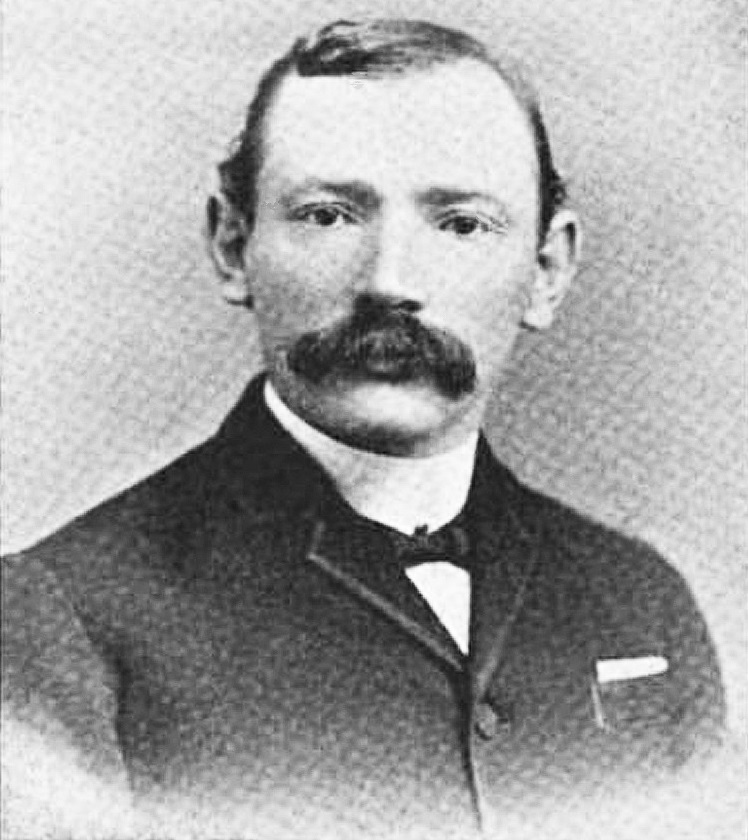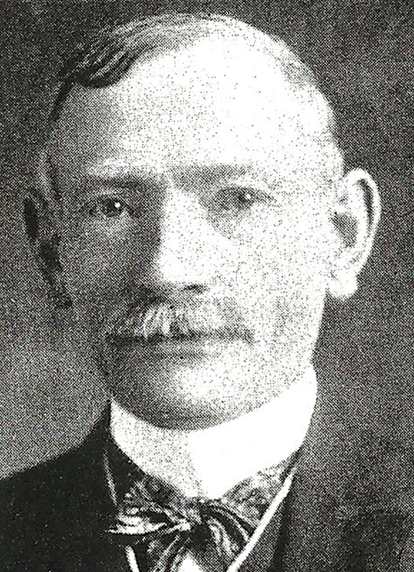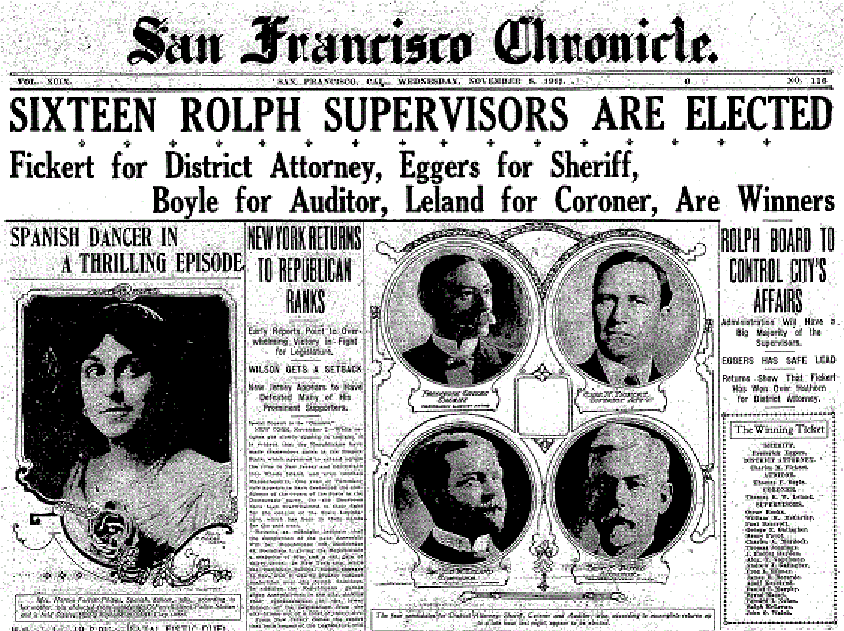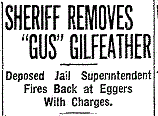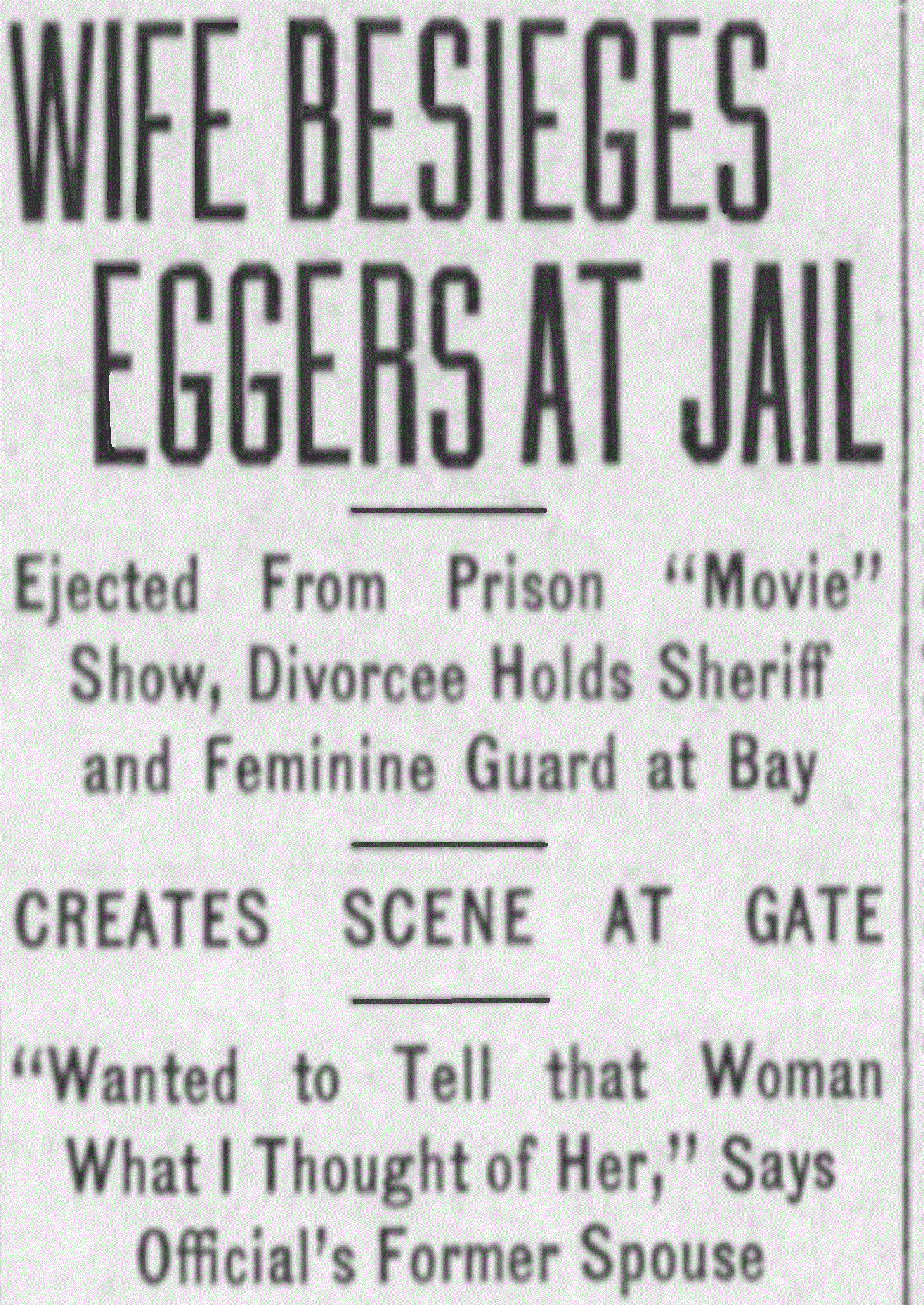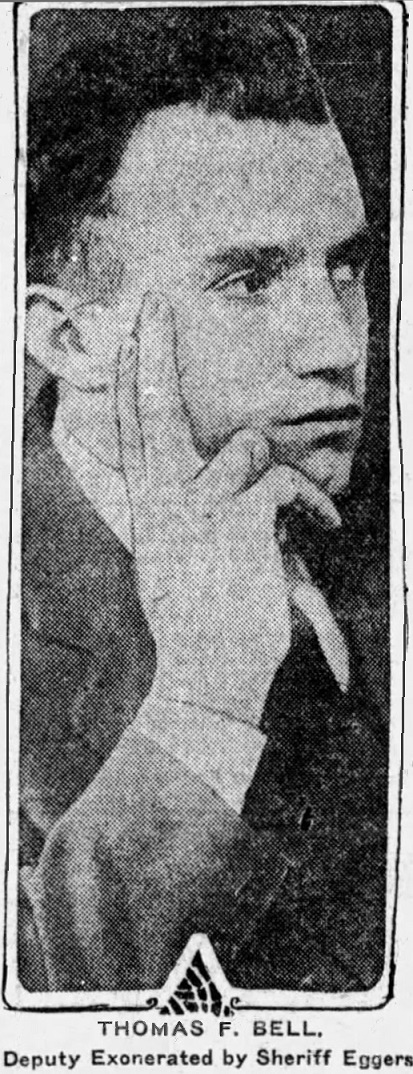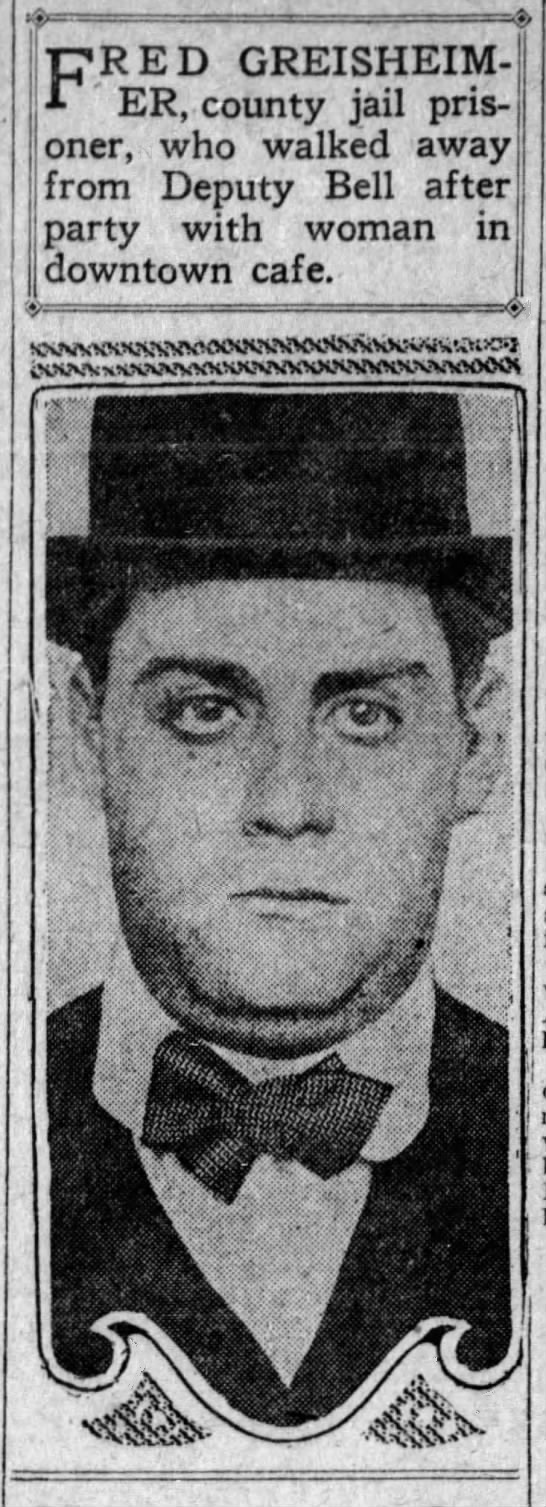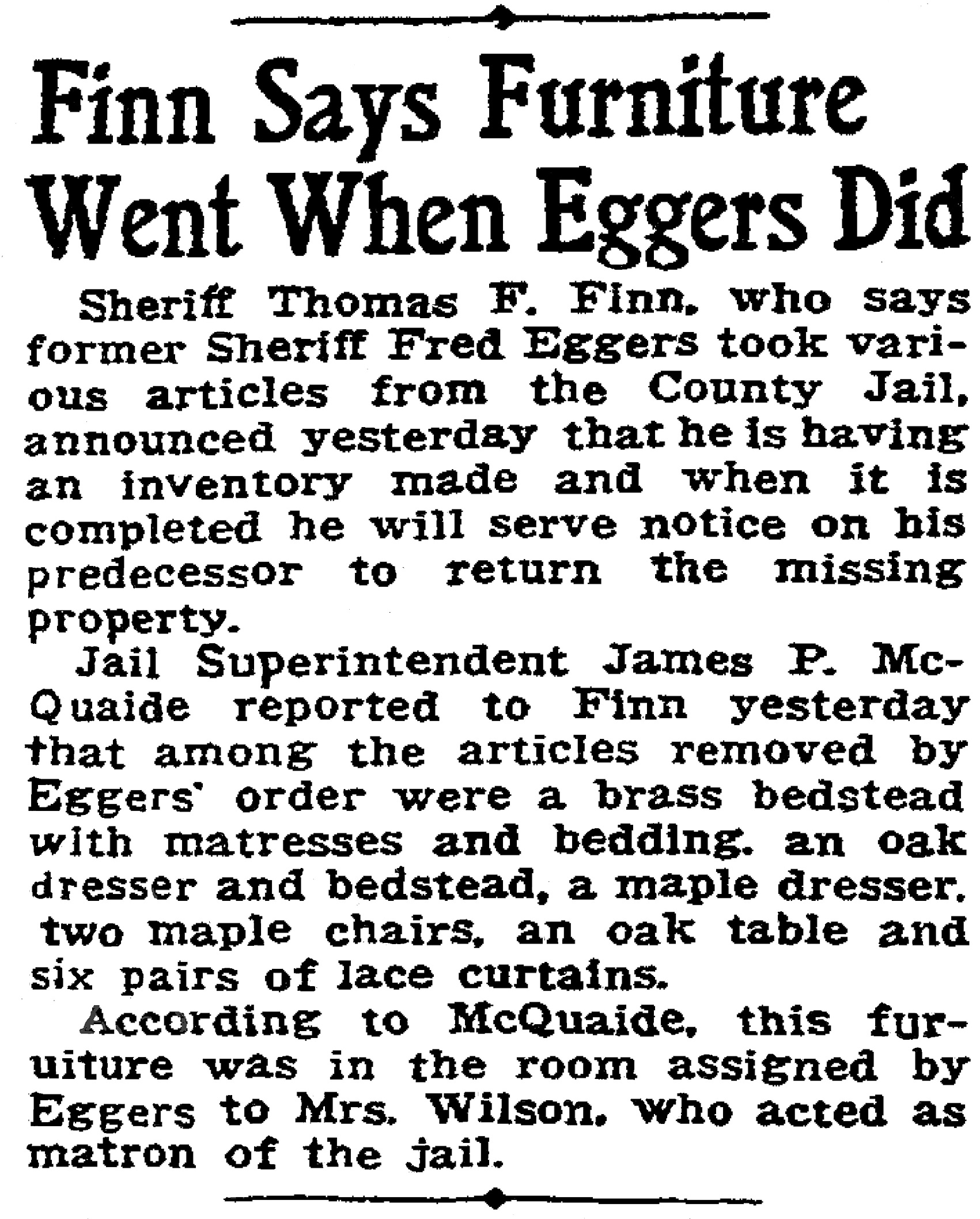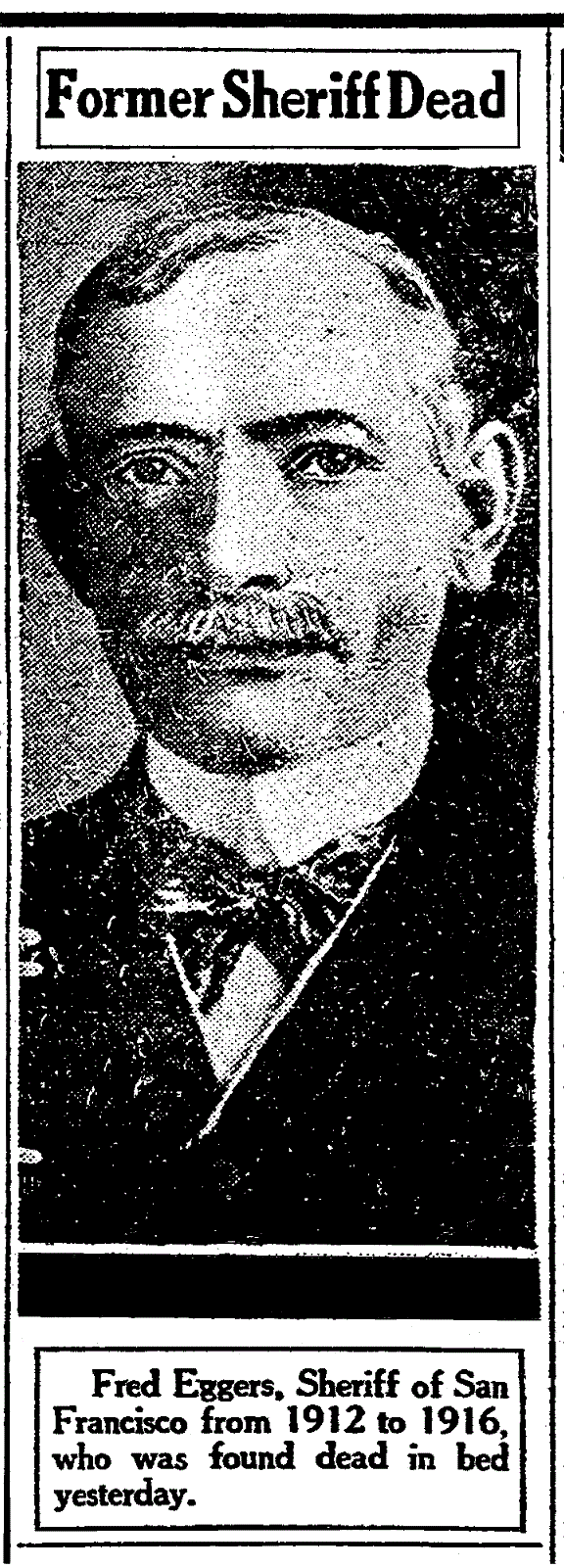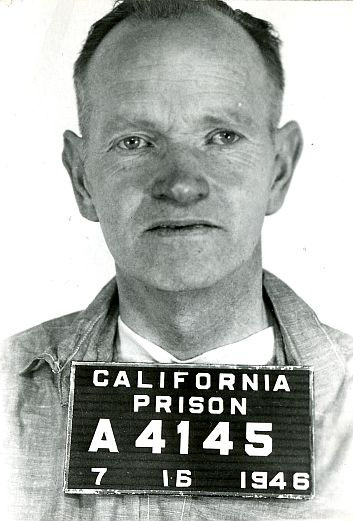Throughout the history of the San Francisco Sheriff’s Department there has been a fascinating diversity of elected sheriffs. From their origins and politics, to their achievements while in office, the arc runs from the exceptional to the borderline criminal.
The great majority of elected and appointed San Francisco sheriffs were not born in San Francisco-- most were European immigrants or originally from the Midwest or East Coast.
They range from dutiful civil servants (John Coffee Hays, Dan Gallagher, Matt Carberry), to paradigm-breaking innovators (Richard Hongisto, Michael Hennessey), and scheming political opportunists (Tom Finn, David Scannell).
Actual diversity would not come until the late 20th and early 21st centuries, which saw the first Black Sheriff (Eugene Brown, 1978), the first woman Sheriff (Vicki Hennessy, 2016), and the first Asian-American Sheriffs (Ross Mirkarimi, 2012 and Paul Miyamoto, 2020).
But truly unique among all elected and appointed San Francisco Sheriffs is Frederick Eggers, who served a single term in office from 1912-1915. Eggers was part dutiful civil servant, part innovator, and a willing partner with scheming political opportunists.
When Fred Eggers was elected Sheriff in November of 1911, the traditional two-year term of elective office for sheriffs had just been increased to four years. It seemed like a golden opportunity for Eggers to build on a winning political base, to add talented and loyal supporters to the Sheriff’s Department payroll, and to make significant improvements in the administrative and operational functions of the Sheriff’s Department.
All of which should have converged to ensure Eggers an extended career as a successful and powerful elected official.
But the story of Frederick Eggers begins and ends with the fact that none of those things would happen. In fact, Eggers’ single term in office would see him become an enabling target for his political enemies, a human magnet for negative newspaper articles, and most astoundingly, find himself in the fight of his political life with two public recall efforts to vote him out as San Francisco’s Sheriff, one of which was led by his wife.
Eggers’ final chapter, and his legacy, may be one of the most hauntingly sad episodes in the long history of San Francisco politics.
An Energetic Emigrant in the Age of Extraordinary Immigration
Frederick Eggers was born in Rotenburg, Germany on April 10, 1858. He was educated in Germany’s public schools and in 1873, at the age of fifteen, traveled alone from Germany to Brooklyn, New York. Exactly why he moved to the United States at such a young age is unknown, but it wouldn’t be surprising if one or more members of Eggers’ family had previously emigrated to America and settled in Brooklyn.
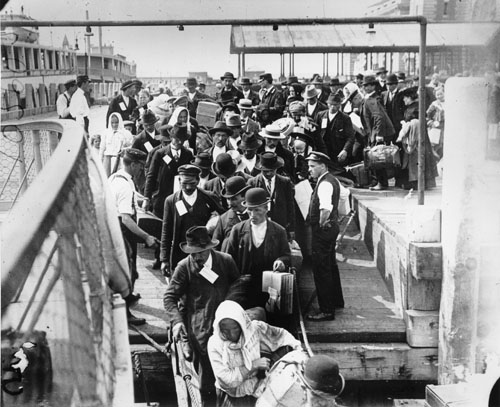
Immigrants arriving at Ellis Island, New York in the 1880s. Immigration statistics from that era give a dramatic picture of the massive influx of Europeans looking to create a new life in a rapidly expanding America during the industrial age. In 1880, some 6,679,943 immigrants came to the United States, an average of over 128,000 per week. And no other country contributed more to that number than Germany with a total of 1,966,742 immigrants. Only Ireland came close with 1,854,571 immigrants.
Eggers apparently spent more than two years working at grocery stores in Brooklyn before traveling to San Francisco in 1876, crossing the continent on the hundredth anniversary of America as a nation. Upon arriving, the eighteen-year-old initially got work as a clerk in Isaac Brownstone’s grocery store at Larkin and Post Streets. By the following year Eggers was working as a butcher at William Becker’s grocery store at Mission and Spear Streets.
When he turned 21 in 1879, Fred Eggers began working as a bartender at several south of Market saloons while living in a building at 424 7th Street—today the former location of that boarding house is directly across 7th Street from two San Francisco County Jails run by the San Francisco Sheriff’s Department.
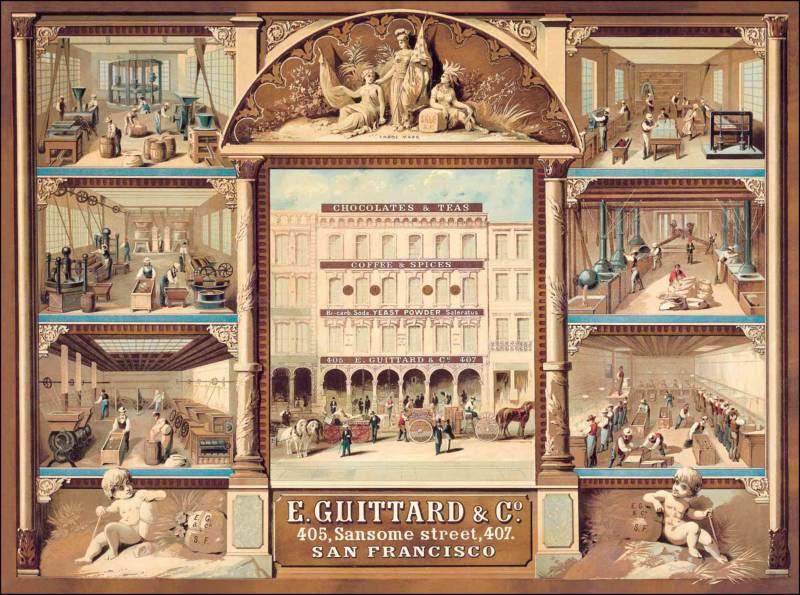
In the late 19th century the tea, coffee, spices and chocolate import business was a thriving enterprise on both coasts and was considered a growth industry and a prestigious career choice. Fred Eggers first joined the E. Guittard & Company in 1883, and then in 1884 Eggers was hired by James A. Folger’s import company as a tea and coffee salesman at their business at 104 California Street, a job he would hold for almost 10 years.
Wasting little time after arriving in San Francisco, Eggers seems to have immersed himself in the vibrant German-American culture then thriving in the City. Perhaps because of his affinity for a career in sales, and the inevitable interaction with scores of people, Fred Eggers made friends easily and started to become well known in the established German enclaves of the Mission and Noe Valley neighborhoods.
In 1879 at age twenty-one, Fred Eggers married 19-year-old Marie Rauscher (later “Mary”) from a local German family. The newlyweds would have six children between the years 1881 and 1894, but they did not set up their first long term home until 1894, at 302 Gough Street, a house in which they lived for almost 12 years.
The Eggers first child, Harry William Eggers, was born on January 27, 1881.
It was during this period that Eggers started joining a number of San Francisco social and political organizations, and seriously began creating the kind of life he likely imagined when he left New York for San Francisco as a new immigrant ten years before.
He became a member of Eureka Lodge No. 9 of the Independent Order of the Good Templars (a temperance society); the Knights of Pythias (dedicated to the cause of universal peace and understanding among men of good will as a means of achieving peace); the Germany Club; the First Vice President of the California T.P.A. (the Travelers Protective Association of America, a fraternal service club in the United States originally created by and for traveling salesmen); the local Moose Lodge; Chamber of Commerce of San Francisco; the Indoor Yacht Club; and the Hannoverian Verein (a club devoted to Hanoverian German horse breeding and training and target shooting).
It seemed if there was an established social club or service organization anywhere in San Francisco at the end of the 19th century, Fred Eggers would eventually become a member of it. His enthusiasm for public service no doubt put him on a path to interact with local politics, which soon became his prime avocation.
By 1902 he was an elected member of the San Francisco Board of Supervisors and was promoted to sales manager for Leege & Haskins Coffee and Spice House at #3 Front Street San Francisco, a lofty position he held until he began his term as Sheriff in 1912.
Positioning for Public Service and Increasingly Politically Ambitious
For decades in the 19th and early 20th centuries San Francisco politics was defined and driven by powerful and often corrupt political brokers and party organizations which provided reliable paths to elective office. In that era, ambitious candidates for public office who tried to go it alone had a short shelf-life and were essentially shut out of the political process.
Which is why it didn’t take long for Fred Eggers to find an affinity with a specific political party and then align himself with an up-and-coming faction within that party with which he could gain influence, start to coalesce political power, and successfully run for office.
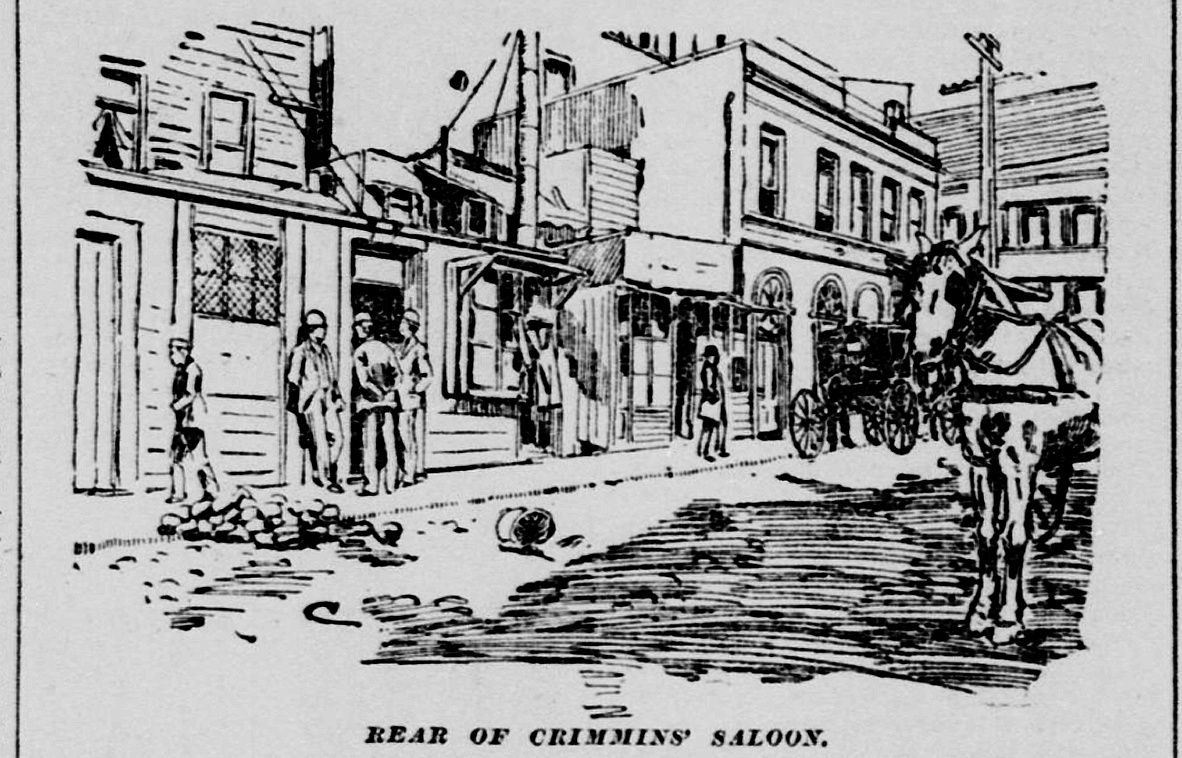
The public headquarters of the Kelly-Crimmins group was Phil Crimmins’ saloon at 16 Third Street between Market and Mission Streets. Although not an official polling place for San Francisco voters, on election days the alley behind Crimmins’ saloon had lines of men at the back door eager to get a stipend for casting ballots using names from a list of eligible, recently deceased, out of town, or vagrant voters.
In the saloon’s back room, additional Crimmins “poll workers” would complete the ballots by ensuring they were cast with the approved names, and then hand them over to Crimmins thugs who would fan out to official polling places and forcefully deposit the votes in ballot boxes.
Today it’s hard to imagine the sheer amount of graft, coercion, ballot box stuffing, and pocket-lining back room deals that routinely defined San Francisco politics and elections from the mid-19th century to the 1920s.
Getting the right people elected meant that fixers like Kelly and Crimmins were able to influence the SF Board of Supervisors and the State legislature, funnel money for civic projects and construction work to hand-picked vendors, and dole out dozens of city, county and state jobs to their base supporters. The many benefits included kick-backs, padded contracts, political donations from the wealthy and big business, and a grateful army of employed henchmen eager to help fix the next primary or general election.
The Kelly-Crimmins organization would achieve great success in San Francisco and other parts of the State before eventually being upended in a battle with Union Labor Party fixer, and eventual convicted San Quentin prisoner, Abe Ruef in the early 1900s.

Martin Kelly joined the San Francisco Fire Department in the late 1870s as an engine driver in a South of Market fire station. His ambition caught the interest of longtime Republican boss William Higgins who got Kelly appointed to the SF Fire Commission in 1878, and then named as Superintendent of County Roads in 1880. Kelly became a brilliant protégé and Higgins’ #1 lieutenant. When Higgins died, Kelly took over as the City’s top Republican boss and political fixer in an alliance with Phil Crimmins.
Eggers was an enthusiastic participant with the goal of eventually running as a delegate himself to begin to establish his political resume. On July 25, 1890, Eggers was elected from the 44th District to represent the party at the August 12th Republican Convention. He joined San Francisco’s Grand Republican Club and in March 1892 was elected Club treasurer.
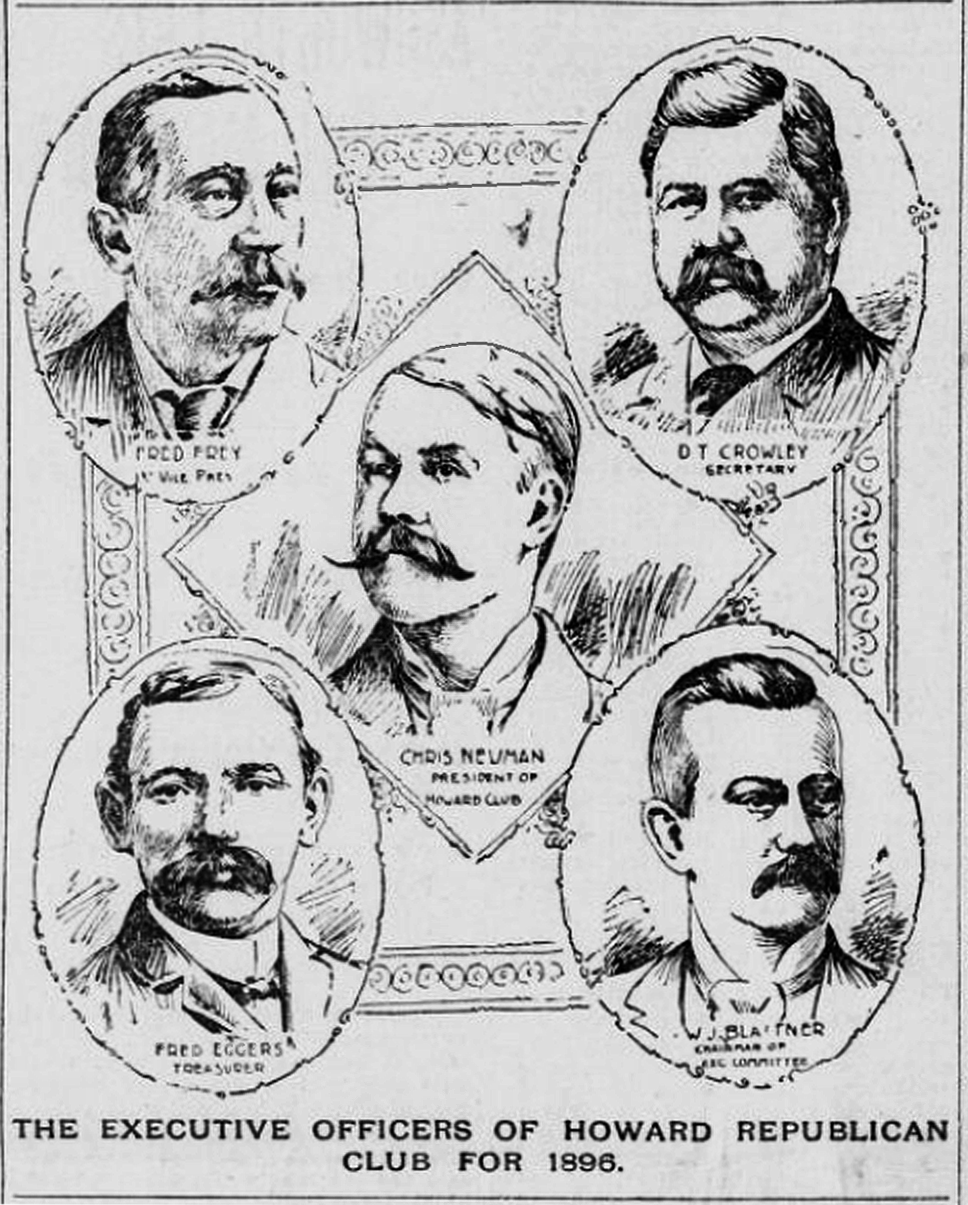
It was no doubt a moment of arrival for Fred Eggers when, on June 13, 1896, his portrait appeared on page 8 of a San Francisco News graphic announcing the new officers of the Howard Club.
Somewhere during his political maturation, Eggers also began to adopt the notion of corruption and graft as accepted elements of the civic process, and the logical rewards for those stepping into the political arena and winning.
Personal and Public Setbacks
Fred Eggers was hit with the first of what would be a steady series of sad and impactful setbacks over final 26 years of his life when, on June 24, 1898, his seventeen-year-old son Harry William Eggers died. There is no mention of how or why Harry died, but in the late 1890s disease and accidents were significant causes of death among younger people.
Harry’s death announcement appeared in several local newspapers which stated that Eggers and his wife Marie would conduct a funeral at their home at 302 Gough street, and that interment would follow at the Odd Fellows Cemetery near Lone Mountain. Their remaining five children, Gracie, Ettie, Arthur, Marie, and Freddie, were in attendance. No public statements by Eggers about the death of his son have been found. Without the discovery of personal remembrances, there is no way to fully gauge the effect of the death of a child on a family but at the very least it must have been traumatic and devastating.
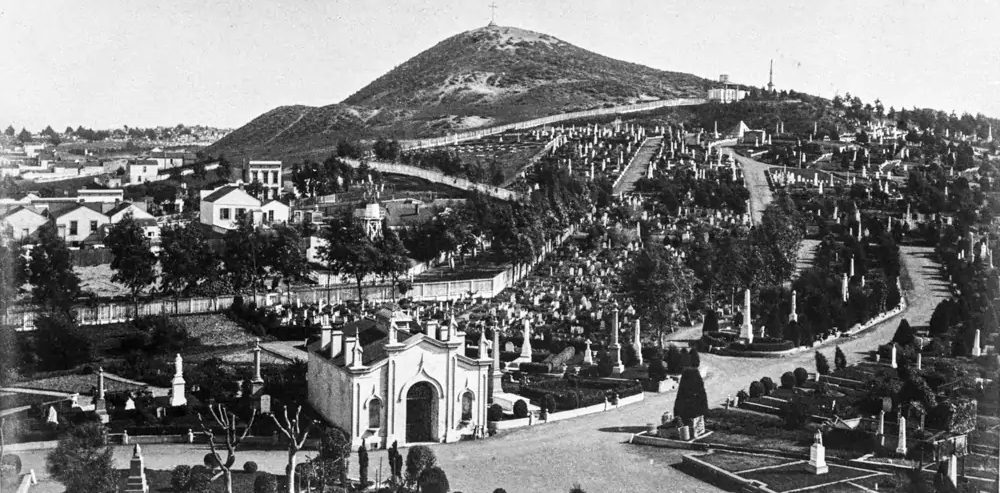
The Odd Fellows Cemetery was originally located in San Francisco’s undeveloped “Outside Lands” (now referred to as the “Inner Richmond” district of San Francisco). The land on which the cemetery was located was legally deeded by Samuel Brannan in 1851 to the first Odd Fellows Lodge established in the City.
The Odd Fellows Cemetery officially opened in November 1865, planned as a subdivision of existing Lone Mountain Cemetery. The cemetery was bordered by Geary and Turk Streets, and Parker Ave and Arguello Blvd. The grounds consisted of 27 acres and was surrounded by three other cemeteries: the Lone Mountain/Laurel (1854-1901), Calvary (1860-1940), and Masonic (1864-1901) Cemeteries.
As the city of San Francisco grew around the four cemeteries there was intense neighborhood and business pressure to relocate them. Finally in 1933, the first removals of San Francisco’s dead from the Odd Fellows Cemetery began and eventually over 26,000 remains were removed to Greenlawn Cemetery in Colma.
All that remains of the original Odd Fellows Cemetery on the western slopes of Lone Mountain is the Columbarium, an impressively designed repository for cremated remains that is still in business today (run by the Neptune Society).
The General Election of November 6, 1901 saw the defeat of the Republican ticket across the board as Eugene Schmitz’s Union Labor Party (ULP) upended the City’s political landscape. Fred Eggers barely managed to dodge the ULP landslide by finishing 17th out of 36 Board candidates, with 15,952 votes, at a time when there were 18 elected members on the Board.
It should have been a celebratory moment for Eggers, but he faced a series of major challenges to his election when the ULP claimed that Eggers and George Alpers, the Republican candidate who finished 18th among the Board candidates, won their seats because of voting fraud in several City districts. Mayor Schmitz unseated Eggers and Alpers from the Board and the issue went back and forth in the lower courts for months. Eggers and Alpers regained their seats and then lost them again after a Superior Court ruling.
The issue of the legitimacy of Eggers’ and Alpers’ 1901 election wins wasn’t resolved until October 1903 when the California Supreme Court ruled the two Republicans would finish their terms. Since all city elective terms were for two years, by then Eggers and Alpers were already running for reelection to the Board the year the final ruling was made.
Both Fred Eggers and George Alpers won their reelection bids for a second two-year term on the Board of Supervisors in the General Election of November 1903. In his second term Eggers proved to have a deft political hand, successfully partnering with the Democratic majority on the Board on several critical issues including the creation of the Municipal Railway and the initial development of San Francisco’s massive Yosemite National Park Hetch Hetchy water supply project.
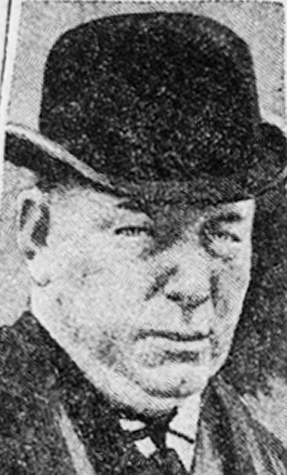
Phil Crimmins ran roughshod over the Republican Party in San Francisco during the late 1880s, the 1890s, and early 1900s. He became expert at consolidating power, making deals, and dispensing favors to his followers. At an August 21, 1900 Republican County Committee meeting Crimmins purged members of the current Board of Directors not beholden to him; as the SF Examiner headline succinctly put it, "Phil Crimmins Succeeds in Again Securing the Complete Mastery of the Republican County Committee".
The Fusion strategy didn’t work. Schmitz and the ULP won again, and won big.
As part of the City-wide ULP slap-down, Eggers lost his race for Tax Collector. Union Labor Party candidate J. F. Nichols got 38,512 votes to Eggers’ 28,660, and just like that Fred Eggers found himself scrambling to find his next potential landing place in elective office. He proceeded to edge away from any more dallying with the Fusion Party and worked to reingratiate himself back with the City’s traditional Republican Party.
During his terms as Mayor, Eugene Schmitz and his Union Labor Party boss and fixer Abe Ruef worked hard to tie up various loose political ends around town. In the August 1906 election Ruef tried to capture delegate wins in the City’s various Districts, but Eggers managed to win the 36th District even after Ruef described Eggers in the SF Chronicle as “that former Supervisor and coffee peddler” and “a lieutenant of Phil Crimmins….”
By then, Crimmins was the poster boy for political corruption and malfeasance in San Francisco. A role the ULP’s Abe Ruef and Eugene Schmitz would soon take on.
By 1908 Eggers was described as heading “a wing of the Republican Party” and he was back in the fold of the Howard Republican Club making speeches around the City in support of President William Taft. In 1909 the Eggers family moved into what was to be their permanent home, at 142 Guerrero Street (the building is still there).
All of which led to Fred Eggers registering for the Republican primary for Sheriff in June of 1909, the first primary election held in San Francisco history. Six other Republicans also entered that historic primary as candidates for sheriff, but Eggers received almost two thousand more votes (6,812) than runner up John J. Deane (4,835).
But in the November 2, 1909 General Election the ULP got its revenge when Eggers (19,797 votes) finished third out of four candidates for sheriff to the Union Labor Party’s Thomas Finn (21,544) and incumbent Democratic Sheriff Lawrence Dolan (19,972). Selig Schulberg, a Russian emigrant and the Socialist Party candidate, managed to get 1,469 votes.
One Last Election Becomes a Turning Point of No Return
It had been a rough eleven years for Fred Eggers. After a legally entangled first term as a member of the Board of Supervisors, after challenging the mighty ULP and running for Tax Collector and losing, and now coming up short in his 1909 bid for Sheriff, Eggers must have taken stock, wondering just where his career was going as he turned 51 years old. He had lost a teenaged son in 1898 and still had a wife and family of five to support. And, apparently, his best prospect moving forward was to challenge ULP top dog Tom Finn for Sheriff all over again in 1911.
On the plus side, Eggers was back in the Republican fold. He had run for public office many times and had a name that attracted voters. He also apparently still had the ambition to create a positive legacy for himself and his family.
Recalling the challenges of his immigrant past, Fred Eggers probably figuratively hitched up his pants, put his head down and went one more round to try and grab the big brass political ring.
Two factors created momentum for Eggers in his second run for the office of Sheriff.
First, the corruption scandals and trials that would eventually take Abe Ruef and his Union Labor Party down started to become public in late 1906. And while the ULP was still powerful, after Mayor Eugene Schmitz was found guilty of corruption and bribery in 1907 the Labor Party was looking increasingly vulnerable.
Another symbolic uplift came on June 29, 1911 when the “Fred Eggers Club” was formed in the 28th Assembly District. Eggers played on that momentum by publicly coming out early and announcing he was going to win the Republican primary and then challenge Finn for Sheriff in the November General Election. After that, several other “Fred Eggers Clubs” blossomed around town.

It’s hard to understand today, but early in the 20th century California allowed officials to hold two elected offices at the same time. Amazingly, Tom Finn (above) was elected to the California State Senate in November 1908, prior to winning his first term as San Francisco’s Sheriff in November 1909. Finn was re-elected to the Senate three more times: November 1910, November 1912 and November 1914, serving in the 38th through 41st Sessions of the California Senate.
Virtually every elected San Francisco official and active politician had a specific City district or ward that was their prime political base. These districts were traditionally considered untouchable until both Finn and Eggers conducted back room maneuvers to have each other’s home districts redrawn, to either absorb them into other districts or to fully eliminate them. Both of their efforts failed but it set an initial low bar in as the campaign for Sheriff began to heat up.
Down-ballot candidates’ affiliations in the Mayor race would also play a pivotal role in the outcome of the 1911 election.
With Mayor Eugene Schmitz having been forced from office in June 1907 after his conviction on charges of extortion and bribery, there was an opening to topple the Union Labor Party’s political dominance up and down the 1911 ballot, and the Republican Party was poised to do just that.
In a last-ditch attempt to hold on to their labor base, the ULP managed to get SF labor leader P. H. McCarthy elected Mayor in 1909. “Pin Head” McCarthy, as his opponents nicknamed him, did manage to enact several labor reforms as Mayor, but his inability to follow through on a number of the ULP’s post-1906 earthquake rebuild promises would be his undoing. McCarthy’s two-year term would signal the sputtering end of the Labor Party’s dominance in San Francisco.

“Sunny Jim” Rolph was born on August 23, 1869 on Minna Street between 9th and 10th Streets. In 1910 Rolph was picked to be the co-president of San Francisco’s effort to be named the host city of the 1915 Pan American Exposition, a world’s fair to celebrate the opening of the Panama Canal. His involvement and ultimate success in securing the Exposition for San Francisco generated innumerable articles in local and State newspapers which celebrated his success and made him a household name. None of which hurt his 1911 campaign to become San Francisco’s 30th Mayor.
Stepping up to lead the Republicans was businessman James Rolph Jr., popularly known as “Sunny Jim” for his energetic personality and unquenchable bonhomie. Rolph was a native San Franciscan from South of the Slot who worked his way up in the business world to become a shipping magnate and the president of two banks. The City’s business leaders saw Rolph as the energetic go-getter who could end the Union Labor Party’s electoral dominance with a win as Mayor.
Fred Eggers immediately saw the advantage of becoming a “Rolph man” and was adopted as part of Rolph’s campaign slate in the 1911 General Election. The quid and the pro quo were evident in the innumerable stump speeches Rolph and Eggers made to political rallies, civic groups, community organizations, and various political clubs in which they referenced their support for each other’s candidacy.
Eggers’ generic statement was picked up by the SF Chronicle at a rally just before the election: “I will support James Rolph in every effort he puts forth as Mayor for the betterment of San Francisco and shall consider myself one of his cabinet.”
In contrast, throughout the campaign incumbent Sheriff Tom Finn was plagued by accusations of “bossism” because of his ties to Schmitz and Ruef. It was hard to argue that the ULP was looking out for the working man when it was busy lining its pockets with public graft and union extortion.
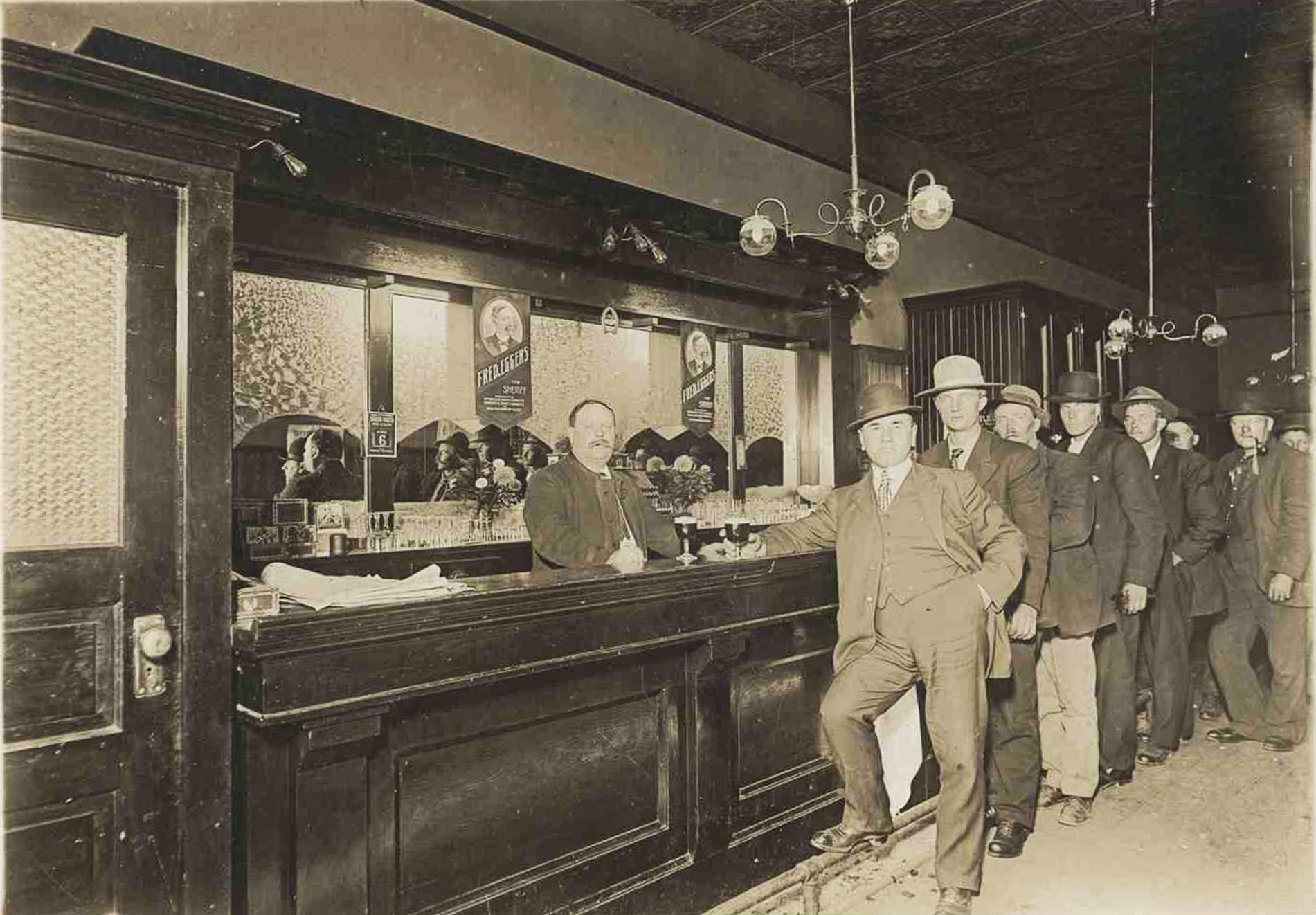
Saloons and bars in the South of Market and Mission Districts of San Francisco were hubs of political activity in the late 19th and early 20th centuries, as these "Fred Eggers for Sheriff" posters illustrate. In that era these were vibrant "social media" centers for working people, neighborhoods, and ethnic communities.
The primary election was held on September 26, 1911 and Eggers (29,278 votes) and ULP incumbent Tom Finn (27,404 votes) had the two highest vote totals among the six candidates running for Sheriff. They would have a face-off in the November 7th General Election.
Also in the primary, James Rolph was elected outright by winning a plurality over Eugene Schmitz and three other candidates for Mayor. This gave Rolph two months to do a victory tour around the City and campaign for the various down-ballot candidates he supported. And that paid off big in the General Election.
Just as the Union Labor Party swept into power with their 1901 political tsunami, James Rolph and the Republicans swept the ULP out of power just as decisively in November 1911.
In the Sheriff’s race, Fred Eggers (35,152 votes) beat incumbent Tom Finn (33,726), and fully 16 of the 18 elected members of the Board of Supervisors were Rolph candidates. It was one of the most sweeping political victories in San Francisco history.
“Sunny Jim” Rolph’s first electoral win would propel him to serve the longest tenure as Mayor in the City’s history, 19 years. Rolph resigned from office on January 6, 1931 to assume his new duties as the recently elected Governor of California.
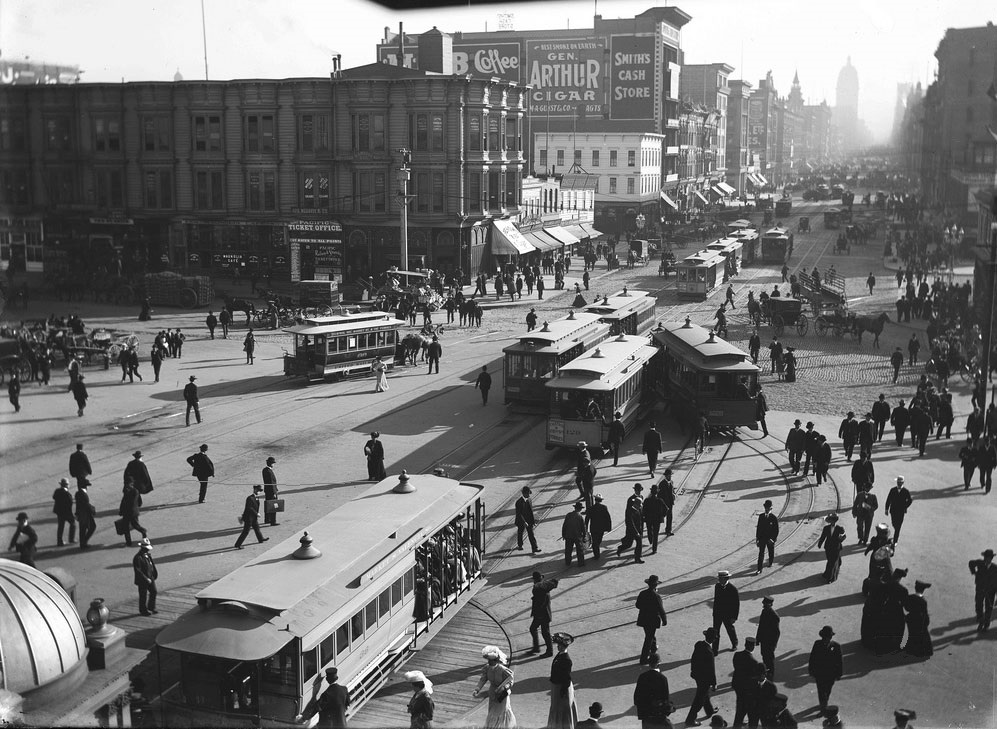
San Francisco's bustling Market Street on August 23, 1905. The dizzying maze of cable car and street car loops in front of the Ferry Building were ground zero for the dozens of transit lines that criss-crossed the entire City. Not only were there competing trolly and streetcar companies running independent lines up and down Market Street, it was a time when automoblies were becoming more common and horse-drawn wagons and buggies were still the main mode of transportation.
Fred Eggers’ Term as Sheriff Starts with a Series of Sideway Turns
The very first order of business for Sheriff-elect Fred Eggers was to make the many appointments allowed a newly elected Sheriff of San Francisco. This was an age of big patronage, when the qualifications to get a job in City government started and stopped with hiring those who did the most to get the candidate elected to office.
Eggers had fully sixty-six individual appointments to make, which comprised a total salary layout of $72,000. It’s important to understand that this was the entire number of employees working for the Sheriff’s Department. Like his predecessors, Eggers was expected to start his tenure as San Francisco’s newly elected Sheriff by firing virtually every employee in the Department and replacing them with his own people. At the time there were few civil service protections for city employees so knowledge and experience meant nothing, and each election meant a lot of people would likely lose their jobs.
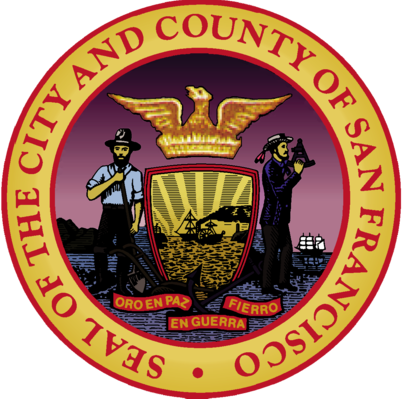
San Francisco’s Civil Service Commission was formed in 1900, one of the oldest created in the country. The patronage system that historically drove employement in local government would start to change on March 2, 1914, when the Civil Service Commission declared that all employees in the City and County jails would be appointed on the basis of their performance on civil service examinations. The same applied to a number of other City jobs, including telephone operators in all municipal offices and municipal granite cutters. Future amendments to the City’s Charter would further expand the Commission’s power and oversight on City and County employment.
• one attorney (@ $1,800 a year)
• one chief bookkeeper ($1,800/yr)
• three assistant bookkeepers ($150/yr each)
• ten office deputy sheriffs ($1,500/yr each)
• fourteen bailiffs ($1,200/yr each)
• one chief jailer ($1,800/yr)
• ten jailers ($1,200/yr each)
• one superintendent of branch jail ($1,800/yr)
• twenty-two branch jail guards ($600/yr each)
• one matron ($900/yr)
• one commissary manager (1,500/yr)
• one van driver ($900/yr)
The Sheriff’s salary was $7,999.92 a year; the Undersheriff made $2,400.
After the election, Sheriff-elect Eggers promised to follow Mayor-elect Rolph’s pronouncement that he was creating the “no consideration club”, meaning he would take his time over the next month before making any staffing decisions. This would give the many political organizations and individuals who helped Rolph and Eggers get elected plenty of time to apply for their jobs of choice.
One hire that Eggers immediately made was to bring Henry K. Beatty on as his attorney. Beatty would be a very busy man in the next several years.
In early January 1912 Eggers made his staffing picks public and, with several exceptions, he did dismiss virtually the entire Sheriff’s Department staff that had served under former Sheriff Tom Finn. One former Finn employee he retained was Owen Augustus “Gus” Gilfether (his last name often spelled "Gilfeather" in the newspapers), a druggist by trade with a criminal record, whom Eggers made his Superintendent of the County Jails.
Sheriff Eggers also picked Fred W. Klevesahl, a Mission District butcher, to be his Undersheriff (then spelled as two separate words) and Robert Hall, modestly known as “the boss of the Mission”, to run the County Jail commissary. The various other deputy, guard, and civilian positions were filled by those who directly helped Eggers win the Sheriff’s race, those hired from lists supplied by the various clubs and political organizations that had endorsed Eggers, and several members of Eggers’ family.
Experience in law enforcement, knowledge of county jail management, and training of any kind was not prioritized as a hiring factor for the new Sheriff.
While that might not seem like a very promising start to successfully administering a city law enforcement agency, what developed over the next four years would in retrospect make “not very promising” end up looking like a lofty, unreachable goal.
Escapes, Escapades, Employee HR Issues from Hell
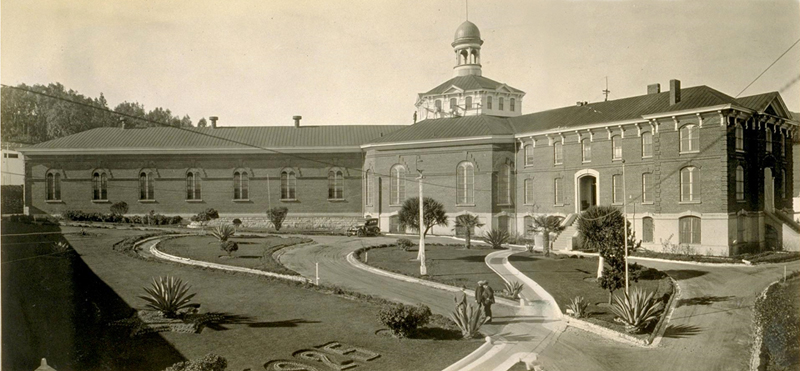
Until April 18, 1906 there were four working jails in San Francisco: the City Prison booking facility in the Kearny Street Hall of Justice run by the Police Department; and the old Broadway Jail in North Beach, and the Ingleside Jail men’s and women’s facilities in the southwestern corner of the City (above), administered by the Sheriff’s Department.
After the great earthquake and fire of 1906 there were only two jails— the male and female lock-ups comprising the Ingleside Jail. During the earthquake and fire the Broadway Jail was heavily damaged and then dynamited as a fire break, and the Kearny Street Hall of Justice ended up a completely destroyed empty shell.
When Fred Eggers was sworn into office in January 1912, the Kearny Street Hall of Justice replacement building was several years away from opening, so the Ingleside Jail was the Sheriff Department’s only working facility. In June of 1912 there were 260 men and 24 women prisoners housed at the Ingleside jails.
Which is why by early January 1912 John Black had spent fully seven years in the Ingleside Jail waiting to be cleared for transport to Folsom. Over that time Black diligently developed a thriving drug-smuggling trade inside the jail which eventually involved virtually every trustee (inmate worker) in the jail.
Getting word that there was literally going to be a new sheriff in town, and one who might not keep a closed eye to his business arrangements, Black escaped from the Ingleside Jail with at least $2,700 in drug money in his pocket only days before Eggers was to assume office.
The escape was curious in that Black was held in what was called “the felony wing” at Ingleside which was essentially a jail within the men’s jail, with no cell windows facing outside. It was later discovered that his interior cell bars had been sawed and bent from the outside, that he got over the jail wall by accessing a locked guard tower not used at night. Several witnesses also saw a black sedan speed down a back road to pick him up and complete the escape.
Then-Sheriff Tom Finn gamely went through the motions of trying to track Black down, and even offered a $1,000 reward for his recapture. As it turned out, John Black had already left the country soon after his escape from the San Francisco County Jail.
All of which eventually led to front page headlines in the February 6, 1912 edition of the San Francisco Call newspaper: “Trusties’ ‘Dope’ Ring in County Jail Broken”, “Thriving Industry in Penal Institution Stopped by Eggers and Gilfether”.
It hadn’t taken long for new Superintendent of Jails Gus Gilfether to uncover John Black’s dope-smuggling enterprise at the Ingleside Jail. It made for the kind of headlines a newly elected official like Eggers can only dream of, especially when it’s at the expense of the elected official you just replaced.
One step foward, and then one back. On February 1, 1912 the San Francisco Grand Jury, after getting multiple reports of recent prisoner abuses at the Ingleside Jail, compelled Eggers to transport seventeen chained felony-charged prisoners from Ingleside to the Jury's court chambers. They heard testimony of jail prisoners being beaten, drugs still rampant in the facility and the oppressiveness of the new Jails Superintendent, O. A. "Gus" Gilfether. The Grand Jury also heard from several county jail trustees who testified that everything at Ingleside was actually going just great. The Grand Jury published the testimony but did not file any specific charges.
Happening only a month after Eggers was sworn in as Sheriff, this negative episode should have been an early wake-up call and an opportunity to re-set, but the impression was that, now he was Sheriff, Fred Eggers did not have to answer to anyone.
In May 1907, ULP boss Abraham Ruef was found guilty of bribery and sentenced to 14 years at San Quentin prison. In early 1912 he was brought back to San Francisco and housed in the county jail to testify at the trial of former ULP Mayor Eugene Schmitz, also charged with bribery. After Ruef refused in court to testify, he was transported back to San Quentin by Sheriff’s Deputy William O’Kane on March 7, 1912.
The screaming headlines on the front page of the March 9, 1912 San Francisco Chronicle had to make Sheriff Fred Eggers do a spit-take with his morning coffee:
“Abe Ruef Gives Clandestine Banquet”
“Deputy Sheriff Helps Convict No. 24,911
Steal Five Hours’ Merriment”
Deputy O’Kane and a manacled Ruef had boarded an SF ferry boat to Sausalito at 3:15 PM en route to take Ruef back to San Quentin prison by 4:30 PM on the 7th of March. A friend of Ruef’s, one Dr. Sichel, was somehow allowed to join the pair for the ferry ride.
At Sausalito the trio boarded a Northwestern Pacific Railroad train to meet San Quentin’s horse-drawn stage at Greenbrae station, but instead of getting off there they stayed on the train and got off at San Rafael. There they ordered up a car and the group drove to Caramelli’s restaurant at 618 4th Street in San Rafael, where they were soon met by another of Ruef’s friends, Dr. Wade Stone. The group casually dined for several hours on steak, spaghetti, and pie, accompanied by some Italian wine. Dr. Stone may or may not have brought two women to the party.
After several hours the group drove to Dr. Stone’s home for after dinner drinks. After another couple of hours, Dep. O’Kane and Abe Ruef finally arrived at the front gate of San Quentin prison sometime after 11PM.
The story took several days to get out, but get out it did. A chagrined Sheriff Eggers traveled to Marin County with Dep. O’Kane the day after the story broke to retrace his deputy’s circuitous route to Quentin, after which Eggers suspended O’Kane pending the investigation. Eventually Deputy O’Kane was given a 30-day suspension without pay, with Eggers telling the newspapers, “I at first thought of dismissing O’Kane but as he has a family to support and his record, aside from the Ruef matter, was good I concluded that this punishment would be too severe. He admitted his mistake and told me he was sorry for it.”
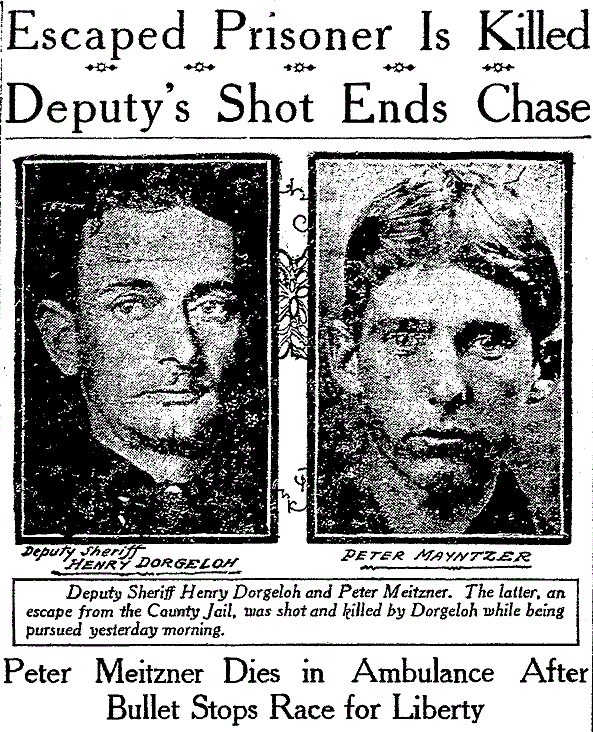
On Friday morning at 10:00 December 28, 1912, prisoner Peter Meitzner, 30, escaped from the Ingleside County Jail. Meitzner was part of a ten man work crew loading sand wagons at San Jose and Joost Avenues several blocks from the jail when he bolted from the group, ran across San Jose Avenue, disappeared behind a vacant house then jumped into a passing automobile.
Deputies Henry Dorgeloh and Peter Michaels were overseeing the work crew, and Deputy Dorgeloh was assigned to track down and recapture Meitzner. Dep. Dorgeloh immediately went to Stockton and Pacific Streets, known as location of "morphine fiends and petty thieves and which seems to center in the heart of Chinatown". Throughout that Friday Dep. Dorgeloh watched the intersection without seeing Peter Meitzner. Dorgeloh returned the next morning and at 10AM spotted Meitzner, who also spotted him and began running. They both ran up Stockton to Broadway and when Meitzner began running up Broadway Dep. Dorgeloh pulled out his .32 caliber revolver and fired one shot at Meitzner.
Meitzner turned up Churchill Street (now Turk Murphy Lane) and then collapsed in a vacant lot. He had been shot in the back, the bullet going through his lungs. An ambulance was called but Meitzner died before he got to the hospital. During the chase a crowd had gathered and numerous witnesses stated that Dep. Dorgeloh never shouted for Meitzner to stop or identified himself as a deputy sheriff.
At the hospital a shaken Dorgeloh stated to reporters, "I did not shoot to kill him. I shot at his legs but my revolver must have kicked up. It was a run right up the hill and I was out of breath-- too much out of breath to shout at the man to stop. I am sorry the bullet hit where it did."
Meitzner was doing five months misdemeanor time for stealing copper wire from the City Electric Company. Deputy Dorgeloh, appointed by Sheriff Eggers in January 1912, was arrested by San Francisco Police detectives and charged with murder. He was released on $3,000 bail and after a Coronor's Jury declared the killing justified, all charges were dropped against Dep. Dorgeloh on January 13, 1913.
While this was not a major incident there were other similar fatal shootings by deputies of escaped prisoners from the Ingleside County Jail during Sheriff Eggers' term of office. Anecdotally, it possibly points to an order from Eggers that any prisoner who escapes from Ingleside should be killed as an example, not so much for escaping but for escaping without making prior "arrangements".
Eggers, sounding like a man beginning to drown, told the local newspapers, “I have instructed my attorney to make a full investigation of the charges against Gilfeather and Woodhall and if I find they are well founded, will certainly suspend them. But at present I am fully satisfied with their conduct, and have no intention of immediately suspending them.”
And the hits kept on coming. The front page of the Saturday June 22, 1912 SF Chronicle featured this headlined story: “Saloon Stock Fades as Deputy Slumbers”. Eggers name was in the first sentence of the story about Deputy Sheriff Jim McCann, who was tasked on the night of June 20th with guarding a saloon at 124 Ellis Street, which had been attached for nonpayment of a $1,000 note. When relief Deputy Lipmann reported to the saloon at 6AM the next morning he found Dep. McCann sleeping on a couch and $600 in liquor stock missing.
McCann claimed he was given knockout drops and knew nothing of the theft. Eggers had both saloon owner Leon Labarere and Dep. McCann arrested for the theft, and McCann was eventually fired.
Things went relatively well for two months before Sheriff Eggers had to deal with a unique incident in which Undersheriff Fred C. Klevesahl physically assaulted a deputy at the Ingleside Jail and then threatened to fight Jails Superintendent Gus Gilfether when he interceded. Or, as one wag put it, “Just another day in the Sheriff’s office”.
The ubiquitous Chronicle headline on Monday morning September 2, 1912 shouted out,
“Officials Battle in Shadow of Jail Wall”,
“Under Sheriff Fred Klevesahl and a Guard Fight While Policemen Look On”
When he became Eggers’ Undersheriff, Fred Klevesahl decided to board his personal horse and buggy at the Ingleside Jail’s horse stables-- which meant free boarding, feed, and grooming at taxpayers’ expense. Stable Guard Charles Bennett asked Klevesahl a number of times to remove the horse and buggy, and after advising Superintendent of Jails Gus Gilfether about the issue, Gilfether also repeatedly asked the Undersheriff to remove his rig and horse.
On Sunday morning September 1, 1912, Charles Bennett reported for work managing the stables at the Ingleside Jail, a short distance away from SFPD’s Ingleside Stationhouse. Waiting for him was an angry Undersheriff Klevesahl who stopped Bennett and demanded to know if he had used Klevesahl’s personal horse for county business. Bennett told the Undersheriff that Jails Superintendent Gus Gilfether had approved using Klevesahl’s horse when no other was available.
Amid a growing number of witnesses, including jail inmates, strolling civilians, and a group of police officers from Ingleside Station, Klevesahl grabbed Bennett’s coat and put his fist up to Bennett’s face, saying “Don’t ever draw a rein over my horse again…!” Bennett defiantly informed Klevesahl that he would use the horse whenever he was ordered to do so. Klevesahl replied, “I am your boss and you come to the Sheriff’s office tomorrow morning. I’m going to have you discharged.”
Bennett turned to walk away when Klevesahl slammed a punch under his left ear, knocking him down and knocking him out. The Undersheriff then took Bennett’s gun away and punched him in the eye then split his upper lip. Bennett scrambled up and ran toward the jail, with Klevesahl following yelling, Bennett reported, “all the names he could put his tongue to”.
At the jail’s front entrance Klevesahl confronted Jails Superintendent Gilfether to complain about Bennett, but Gilfether brushed him off. That’s when Klevesahl challenged Gilfether by yelling "You and I will fight this out yet!" To which Gilfether replied, “If you do, you’ll lose, but you can start now if you want to.” At which time Klevesahl backed down and walked away.
Sheriff Eggers told the SF Call that he had heard of the brawl and that he would make an investigation. Bennet said he would swear out a complaint of assault and robbery against Klevesahl. How the high-profile matter was resolved or hushed up remains a mystery.
And Sheriff Fred Eggers’ first year in office trudged on.

The Ingleside Jail was increasingly criticized as it's physical plant deteriorated. The San Francisco Fire Department's annual inspections of the facility reliably ended with warnings that it was a firetrap waiting to happen and that the structure would fail in a strong earthquake. This is from May 1912.
Among them was a group of angry Sunnyside neighbors whose properties were adjacent or near the Ingleside County Jail. Sheriff Fred Eggers, the Mayor was informed, had “appropriated the water supply of 450 families to use in his cabbage patch” on the grounds of the jail. They were furious, and when Mayor Rolph looked into the matter he found that Sheriff Eggers had, incredibly, indeed approved an unauthorized tap of the 8” city main water pipe in the neighborhood with a 6” pipe to divert water to the jail to sustain the massive garden he established there. This careless act also caused the fire hydrants in the Sunnyside neighborhood to go dry.
The Mayor’s office directed Eggers to immediately remove the tap and find other means of tending the jail garden. The sheer political ineptitude of this incident had to engender incredulity and caustic humor within Sunny Jim’s inner political circle.
The very next day, on September 17, 1912, a group of Ingleside Station police officers got into a scrape with Ingleside deputy sheriffs in front of the jail. Ordered to cut down a number of “gum trees” by Superintendent Gilfether, a group of deputies began cutting when several patrolmen approached and told them to stop. Gilfether told them to keep on cutting, which brought out a group of police officers who rushed out of the stationhouse and confronted the deputies.
One of the deputies told the officers, “You’d better beat it quietly before we make a fuss.” To which one of the patrolmen replied, “You take another hack at that tree and we’ll pinch all of you. Sheriff’s deputies or not.” Both sides then warily retired and the next day the City’s Park Commissioner apparently cooled things down and took jurisdiction over the gum tree issue, but the story made the SF Call and San Francisco Chronicle as yet another in a seemingly endless series of negative stories involving the San Francisco Sheriff’s Department.
About this time, there was some overdue positive personal news for Fred Eggers. On October 12, 1912 his youngest son Fred Eggers Jr., 22, and Miss Olga Landolt, 20, announced their November wedding. Olga was described as a “Mission girl” and very popular in the district, and Fred Jr., a delivery truck driver, as a “successful young businessman”.
A fitting end to Eggers’ first year in office began on October 30th when he fired Augustus “Gus” Gilfether as Superintendent of the County Jails, and appointed Deputy James McQuaide to replace him.
Eggers did not make any charges against Gilfether but stated the change was “for the good of the service.” At the time, he did not mention that jail matron Agnes Wilson had complained directly to the Sheriff about Gilfether’s “conduct” in the women’s jail.
The stable guard’s beating incident at the Ingleside Jail and the Grand Jury’s recommendation to terminate Gilfether for prisoner brutality in March may have played a role, but there were also emerging charges that Gilfether was implicated in the case of nineteen-year-old Clara Steck, who was held against her will in the Ingleside woman’s jail for over two months because she was a “witness in a white slave” case.
The Grand Jury got involved and apparently discovered Steck and several other prisoners had been involuntarily held in the Ingleside County Jail without criminal charges or a warrant simply because the District Attorney’s office wanted them as witnesses in upcoming trials.
Gilfether was directly involved in helping to arrange and enforce these illegal incarcerations, and his firing may have been a preemptive strike by Eggers in an attempt to insulate his office from a yet another potentially big scandal.
After his firing, Gilfether immediately “came out with a declaration of war” against Eggers by going to the newspapers and stating he had information and evidence of serious irregularities in the Sheriff’s office that he would be providing to the Grand Jury. “The people of San Francisco,” Gilfether declared, “will be shocked to learn the condition of things that Eggers has brought about.” The jail commissary, Gilfether claimed, was purchasing supplies from businesses being run by Eggers’ relatives. And he hinted there was more.
On Saturday November 2, Gus Gilfether backed all of those charges up in a long two column expose in the San Francisco Examiner:
“GILFEATHER SAYS SHERIFF’S WIFE IS CAUSE OF ROW”
“Former Superintendent of County Jail Makes Charges Against Whole Eggers Family”
Among Gilfether’s charges were:
• The Sheriff’s wife, Mary Eggers, caused his dismissal because “she wanted to run affairs at the jails”. “I found Mrs. Eggers spreading discontent among the guards and jail officials and injuring good discipline and I told her that she was not running the county jail.”
• Members of Eggers’ family and their friends routinely had lunches and dinners at the jail. Eggers had hired his daughter Marie’s husband, one Valentine Freechtle, to be the assistant jail commissary manager, then promoted him to manager. Gilfether said Val Freechtle bought food for these family meals at the county’s expense and when he asked Mrs. Eggers “to stop feeding her friends and relatives she then told me she would get rid of me”.
• Freechtle also illegally bought all kinds of required jail supplies and services from members of Eggers’ family without a bidding process. This includes sending “a wagon load of harnesses to be repaired at his father’s harness shop”, The Greater San Francisco Harness Company.
• Mrs. Eggers compelled female inmates at the jail to make labor-intensive, expensive lace for her, then paid them far below market value.
• Sheriff Eggers “has conducted bogus investigations into escapes of prisoners from the County Jail”.
• Sheriff Eggers was also accused of compelling all the employees he hired after his election to pay 3% of their salaries to a fund to pay his campaign expenses.
Three days before Christmas 1912, newspaper headlines in the San Francisco Call announced that Gilfether had more good news for Fred Eggers:
“Sheriff’s Opponents Have Recall Petitions Ready”
“Christmas Present for Fred Eggers”
Gilfether told the local newspapers that petitions had been put together to recall Sheriff Fred Eggers from office, and that he and former saloon owner Mark Daniels intended to run Fire Commissioner Lorenzo D. Batchelor for Sheriff in a special recall election. An Eggers recall office was set up in the Investor’s Building at 787 Market Street and by mid-February 1913 it was announced that “100 petitions have been sent out for signatures”.
Curiously, despite the splashy headlines, the Gilfether recall effort seemed to fade quickly, perhaps due to a lack of funding or because some type of backdoor deal was worked out.
On November 24, 1912 infamous Ingleside escapee John Black (now alias “Callaghan”) was found in Alberta, Canada doing a three-month sentence in the local jail for pickpocketing. He was recognized by two detectives who essentially kidnapped him and brought him to the US border in Montana where he was “deported” into the waiting arms of police. Black was shortly returned to the custody of Sheriff Eggers and scheduled for an appearance before the Grand Jury. In the meantime, Black freely talked with newspaper reporters, discussing how easy it was to escape from the Ingleside Jail and about the rumors he'd heard about the brutal treatment of prisoners under Sheriff Eggers' administration.
When Professional Life and Private Life Spectacularly Implode
For Sheriff Fred Eggers 1913 would be a relatively good year in that he would be able to focus on his agenda to bring change to the Sheriff’s Department. But in retrospect, it would be the last relatively good year of his life.
On March 23, 1913 Eggers announced he was going to abolish the traditional black and white striped shirts and pants long worn by county jail prisoners. He would introduce what he termed “futuristic colors”, specifically khaki, blue and gray, to lessen the institutional stigma of being in jail.
In June Eggers got to focus on his #1 pet projects, the Ingleside Jail garden and bakery.
On June 16th he announced the jail garden would expand the “several acres of cabbages” he had planted the previous year and add 11 acres of potatoes and 6 acres of alfalfa. “And it is my idea”, he stated, “that we will soon care for our own sows and supply milk for the jail and for any other city institution”. He estimated that his garden was saving the city $300 a month.
After the Sunnyside water pipe debacle, Eggers said he would also ask the Board of Supervisors for $1,800 to bore a 100 foot well with a pump on the jail’s grounds, which would supply the 5,000 gallons per day required to sustain the expanded garden. The jail bakery was producing 500 pounds of bread daily, with bread and vegetables feeding the prisoners at Ingleside, City Prison, and donated to city hospitals and local charitable organizations around the City.
Despite the positive press, Eggers couldn’t seem to sustain the “smart public servant” image he worked so hard to fashion.
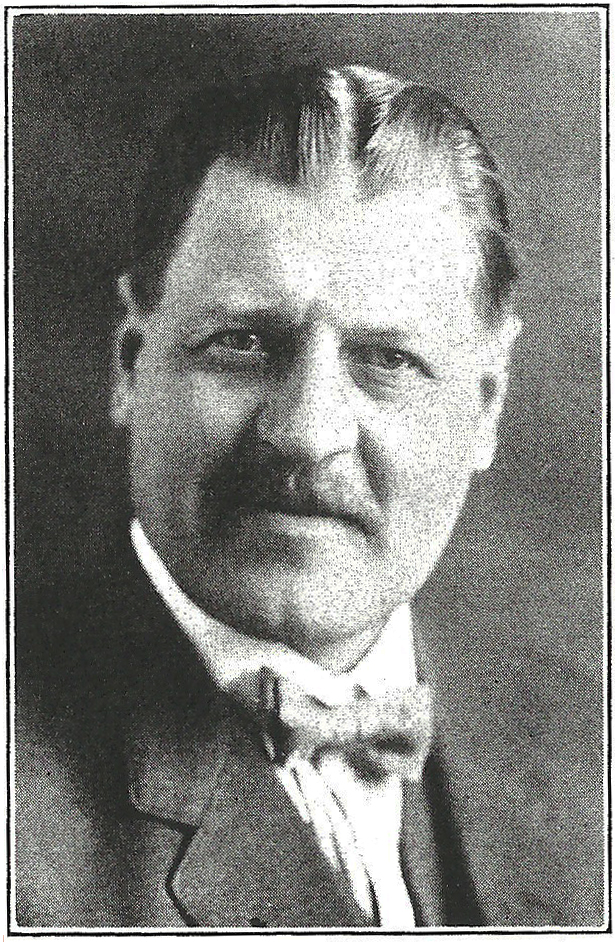
Oscar Roseberg was born in Sweden in 1874. He immigrated to America and went to college in Indianapolis, Indiana before moving to California in 1897. He worked in the "brewery and saloon" business in the Mission District until he was appointed as a San Francisco Deputy Sheriff by Sheriff Eggers in 1912. He married Miss Bertha Fey in December 1900 and they had two children. As many new immigrants did, Roseberg joined a number of social and cultural clubs in San Francisco. He was in charge of county jail prisoner transportation (back and forth from the Ingleside Jail to City Prison and the courts) when Eggers made him Undersheriff in 1914. It would be a temporary promotion.
Then former Jails Superintendent Gus Gilfether generously provided yet another embarrassing moment in Eggers’ term of office when on September 2, 1913 he got into a physical argument with Deputy Sheriff George Wilson “in front of the old City Hall” on Market Street. Eggers himself ended up having to take Dep. Wilson to the Central Emergency Hospital to treat a “badly damaged left eye”. Apparently no charges were filed against Gilfether.
1913’s bundle of bad news wound to a close with the September discovery that $1,400 in “keepers fees” had somehow been lost in the Sheriff’s office; and, following that, Eggers was reprimanded in December by Superior Court Judge Lawlor for using “professional jurors” in San Francisco courtrooms.
The term “professional jurors” refers to the Sheriff’s Department habit at the time of keeping a list of out-of-work, transient, or shady individuals already very familiar with courtrooms who made themselves available to be easily procured for jury duty. It certainly saved time and effort, but judges became exasperated seeing the same scruffy faces on their juries day after day, month after month.
Eggers responded to Judge Lawlor, one assumes with a straight face, by saying that he had “instructed his deputies to summon as trial jurors only men who were known to be respectable citizens who were qualified to act as jurors”.
When the judge still reprimanded him, Eggers played the victim card: “My duties are arduous. We are all working overtime in my office and breaking the 8-hour law. I work from 8:00 in the morning until 1:00 in the morning the next day. I carried out your instructions as well as I could. I told my men to go out in the open and get good men”.
After Judge Lawlor also questioned some thirty deputy sheriffs about the issue, Sheriff Eggers was forced to eventually admit that some number of the jurors his deputies routinely rounded up could be termed “professional”, and promised to do better.
Maybe the last purely positive media involving Fred Eggers appeared in the January 31, 1914 editions of several local papers. Eggers announced that his project to put all Sheriff’s Department staff in uniform for the first time in Department history would happen in February. It was greeted with enthusiasm both in and outside of the Sheriff’s Department, with the SF Examiner headlining “Uniforms for Guards at Jail ‘Beautiful’”.
All Department deputies, jailers, and guards, including the Chief Jailer, Superintendent, and commissary manager, would wear khaki uniforms designed with a “full military cut and military caps”. Each would also wear a shield on the left breast displaying their rank.
Four days later on February 4, 1914 it was announced that Eggers “took a political scalp" by firing Undersheriff Fred W. Klevesahl and putting Deputy Oscar E. Roseberg, who was in charge of prisoner transportation, in his place. Eggers explained that Klevesahl had to go because he was “trying to undermine my influence.”
Curiously, nine months later, Eggers would claim he fired Klevesahl “because I found that he was cashing the pay warrants of some of my deputies and charging them from $5 to $12.50 for the service. I told him to stop but he persisted, so I discharged him.” That was after Klevesahl joined the group attempting to recall Eggers.
Fred Eggers was now at the halfway mark of his first four-year term as Sheriff. No doubt he saw the rest of 1914 as an opportunity to consolidate his political standing and fully prepare to go into his 1915 reelection year strong. The exact opposite would happen.
Hell Hath No Fury Like a Mrs. Fred Eggers Scorned
On February 19, 1914 a divorce suit was filed with the County Clerk’s office by the law firm of Stafford & Stafford on behalf of Mrs. Mary Eggers against Fred Eggers for “extreme cruelty”.
On February 20, 1914 Judge Troutt heard the evidence, including testimony by their daughter Etta Eggers who stated she “tried in vain to reconcile” her parents. The Judge granted the divorce and agreed upon property settlement, which was uncontested by Eggers.
And just like that their 35-year-old marriage was finished (the date of their marriage had been variously reported as 1876, 1879, and 1887).
Several things become immediately obvious. The Eggers had been having serious problems for a least a year and a half, and probably longer. In the divorce suit, Mary Eggers stated that in the past eighteen months Fred Eggers “has not spoken to me once and has persistently remained from home until late at night”, causing her “extreme mental anguish”. She also said she has “been subject to fainting spells”, and that Eggers “wouldn’t help me off the floor” when she fainted.
Mary Eggers specifically added that Eggers “has been sullen and insolent” oddly noting that the extreme cruelty he inflicted on her occurred “in the past year only”.
The background to all this, it would eventually become clear, was that sometime in late 1912 or early 1913, his first two years in office, Fred Eggers began an affair with Sheriff’s Department county jail matron Agnes Wilson (at the time, female deputies were called “matrons” as befits the stuffy misogyny of the post-Victorian era).
It’s instructive to briefly stop here and understand just how much Eggers put on the line to have a relationship with Wilson-- basically everything he had achieved in his life since emigrating to America: a successful commercial career, a wife and family of five, status in the community, and successfully running for public office three times.
It wasn’t uncommon at the time for married men to have a dalliance, and the expectation was that such affairs would remain a secret from their wives and families. But how the bungling Eggers could have possibly expected to “secretly” have an affair with jail matron Agnes Wilson when his son-in-law, his daughter Marie’s husband Val Freechtle, was the jail commissary manager? Add to that Eggers inexplicably allowing his wife to frequently visit the jail and freely chat with the staff. I mean, what could possibly go wrong?
Mary Eggers made it her mission to know exactly what was going on in the Sheriff’s Department at all times, and her son-in-law was just one of a number of jail employees she apparently developed as contacts during Eggers’ first year in office. By the time Eggers and Agnes Wilson were spending quality time together, Mary Eggers was fully aware of their relationship and that’s when things likely started going downhill at home for the couple, with Fred Eggers spending less and less time there.
The divorce property settlement reflected both Mary Eggers’ relentless anger and some combination of guilt and emancipation for Fed Eggers. Mary got the family home at 142 Guerrero Street, another property on the same block, $1,500 in cash and $200 a month alimony from Fred Eggers as long as he remained San Francisco’s Sheriff.
But if Sheriff Eggers had any thoughts that his unchallenged divorce from Mary had put all possible ugliness behind him, she would quickly douse that notion with high grade gasoline and a series of firebombs.
The day after the court granted their divorce, February 22, 1914, was an extraordinary news day even by Eggers’ family standards. The front-page headline above the fold in the February 23rd edition of the morning San Francisco Chronicle tersely summed up the events:
“WIFE BESEIGES EGGERS AT JAIL”, “CREATES SCENE AT GATE”
About 9:00 on the evening of the 22nd, Mary Eggers and her friend, a Mrs. E. Fredericks, drove out to the Ingleside Jail where prisoners were about to watch their usual Sunday night movie in the jail’s large assembly hall. The two went inside the hall and a jail deputy asked her what she was doing there. Mary Eggers replied that she was there to see her son-in-law Val Freechtle who was the commissary manager. Minutes later assistant commissary manager Fred Classen intercepted her and asked Mary and her friend to immediately leave. She refused.
The lights in the assembly hall were turned off and Mrs. Eggers was told there would be no movie so she might as well leave. As soon as Mary and her friend were escorted outside the jail’s main gate, the gate was locked behind them. A determined Mrs. Eggers and her friend waited at the locked gate in the rain, keeping watch on the assembly hall door until 1AM, essentially temporarily trapping Fred Eggers and Agnes Wilson inside.
Mary Eggers and her friend eventually left the jail and drove to the Howard Street address at which she was now staying. There at two in the morning she was interviewed by several newspapermen eager to get some quotes, and Mary was eager to oblige:
“I had only gone to the jail to see my son-in-law and to show my friend the moving pictures, but when I saw the Sheriff and that woman there I thought I would tell them what I thought of them”. At one point, Agnes Wilson was hustled out of the hall. “Neither he [Eggers] nor the woman dared to come out. Finally they opened the door quickly and shot the woman out, surrounded by nine guards, so I could not get near her. If I could have reached her I suppose I would have done something to her.”
Mary Eggers’ final statement that rainy morning was equally chilling. “After that I waited for the Sheriff, but he did not dare to come out, and I suppose he is still hiding, afraid of his wife. He said all I wanted was his money, but I will show him that I am not through with him yet.”
This is the point in the Eggers’ domestic saga where it goes from being colorful, salacious, and somewhat humorous to being just sad. A family publicly torn apart, a woman afraid and angry as her life is turned upside down, and a man whose selfishness and growing lack of integrity is made worse by his penchant for bad decision-making. And the consequences would be truly heartbreaking.
Tumbling Toward a Downward Spiral
Mary Eggers submitted a letter to the San Francisco Grand Jury on February 26, 1914 attacking the personal and professional character of her husband. The Grand Jury set her complaint aside noting that they were not going to get into the middle of what was essentially a domestic dispute.
The following Monday, March 2nd, Mrs. Eggers made big news by announcing to the press that she intended to begin her own effort to recall Fred Eggers from the office of Sheriff and create a special election to decide the issue. Petitions and house-to-house canvassing for signatures throughout the City would soon follow.
“I do not want anyone to think I’m doing this out of spite”, Mary Eggers told the Chronicle, “for that is not the reason at all. I am simply convinced that any man who acts as Sheriff Eggers as acted is not a fit man to serve as a public official.”
To the SF Examiner she stated, “I have a lot of friends who will help me in the fight. They will be glad to circulate the petitions as they know what sort of person the Sheriff is. I will circulate some of the papers myself, and gather all the signatures I can. This is a fight for principal, no spite work. Sheriff Eggers is not fit for the position he now holds.”
She also claimed that former Undersheriff Fred Klevesahl was fired because “he knew too much”, which hinted that Klevesahl might lend his support to the recall effort. To some extent, the vestiges of Gus Gilfeather’s faded December 1912 initial recall of Eggers was likely absorbed into Mary Eggers’ new effort.
Fred Eggers’ extended response was that of a seriously harried public official. “So she is going to have me recalled. All right, let her go ahead. I have tried to do the right thing by her. I just paid Mrs. Eggers $200 alimony for this month, and I am attending to my business to the best of my abilities.
“Mrs. Eggers has always had everything she asked for from me. She wanted a divorce and got it. She wanted a division of property and she got it. She asked for $200 per month alimony and she got it. Now she wants my job, but I draw the line there.”
Three weeks later, on March 23rd, an article appeared in the San Francisco Call with the headline “Sheriff’s Divorced Wife Accuses Woman” describing how Mary Eggers appeared before the Civil Service Commission to file charges against jail matron Agnes Wilson, complaining of “private and official misconduct” with her husband. The piece noted that she had recently sent the same complaint to Mayor James Rolph’s office and to the Board of Police Commission.
In the packed Commission public hearing room that day sat Mary Eggers and her attorney Harry Stafford, Sheriff Eggers and his attorney Henry K. Beatty, and Agnes Wilson and her attorney Thomas O’Connor.
O’Connor asked the Commissioners if there was any inclination on their part “to become the laundry for the Eggers family”. To which Mary Eggers’ attorney Harry Stafford retorted that possibly the Commission “might act as a disinfectant for the county jail”. Commission President Brady said the matter was a “distasteful one” and that the Commission would take the matter “under advisement”.
In a moment of public personal reflection, Fred Eggers stated to an SF Examiner reporter that he welcomed the Civil Service investigation. He also revealingly said, “I have made two mistakes since I assumed office. I permitted my divorced wife to enter the jail and get acquainted with the deputy sheriffs and jailers, and the prisoners. The other mistake was the appointment of my son-in-law, Val H. Freechtle, to a position at the county jail.”
Several weeks later the Civil Service Commission ruled that Mrs. Eggers’ charges were “outside their jurisdiction” and she eventually dropped the case. But not the war on her husband.
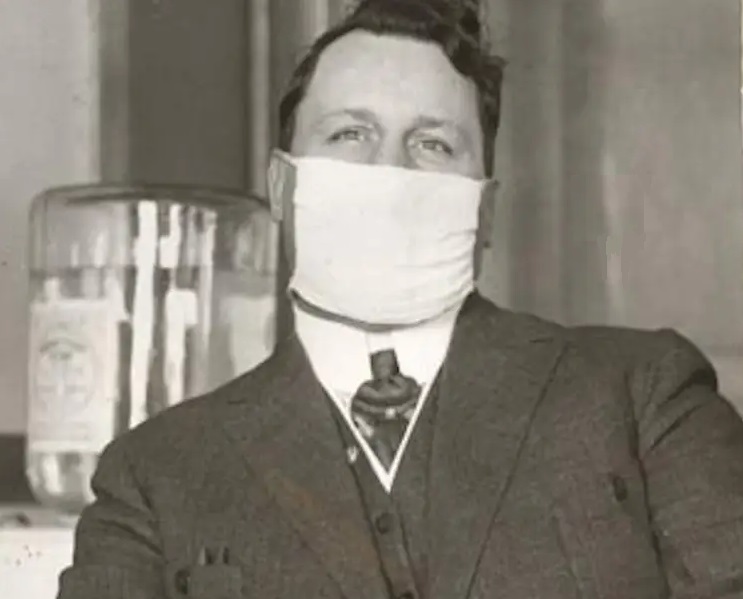
The worldwide H1N1 flu pandemic, also called the "Spanish flu", originated at a US Army camp in Kansas in March 1918, and by the time it was contained in April 1920 over 500 million persons had been infected-- fully one half of the world's population. It is estimated that 50-100 million people worldwide died.
In San Francisco, Board of Supervisors member Andrew Gallagher (above) authored a mandatory mask order which was passed on October 25, 1918, by which time there had been 20,000 flu cases and over 1,000 deaths in the City.
Almost immediately there was resistance to wearing masks from fringe groups. On October 27, 1918 110 San Franciscans were arrested for either not wearing a mask, or improperly wearing a mask; on November 2nd, there were 175 arrests. Those arrested were charged with disturbing the peace and fined $10 or 30 days in jail.
On October 29, 1918 San Francisco Health Inspector Henry Miller saw James Wiser, a blacksmith, standing at the corner of Powell and Market Streets waving his arms and urging people not to wear masks. Miller grabbed Wiser and walked him toward a nearby drug store, insisting he buy a mask. Wiser struck Inspector Miller with "a sack containing a large number of silver dollars" and then knocked him to the ground. Miller pulled out his revolver and fire four shots, hitting Wiser in the arm and leg, grazing the arm of a woman bystander, and hitting another bystander in the leg. All survived.
Wiser was arrested and charged with disturbing the peace, resisting an officer, and assault; Inspector Miller was arrested for assault with a deadly weapon.
San Francisco's mandatory mask ordinance was rescinded on November 11, 1918, tragically just before two additional waves of the epidemic struck San Francisco, infecting many thousands more.
It only took a little over a month before Mary Eggers struck again—this time literally. As usual the San Francisco Examiner’s headline was descriptive and to the point:
“Mrs. Eggers Punches Bailiff in the Mouth”.
Mary Eggers stalked the courts for an opportunity to track down and confront matron Agnes Wilson, now described as the “head matron at the county jail”. She found Wilson testifying in a Superior Court case concerning a county jail female prisoner who was appealing her conviction. With Mary Eggers sitting in the courtroom, Wilson finished testifying and left the courtroom, with Eggers in hot pursuit. Wilson ducked out a side door and when Mary Eggers started after her, bailiff George Malpiede attempted to stop her. Eggers sent a roundhouse punch to Malpiede’s jaw, causing him to bleed from the mouth. Mrs. Eggers quickly left the building before more help arrived.
Mary Eggers was not arrested for the incident.
Looking for some kind of positive press, on Sunday August 16, 1914 Sheriff Eggers brought a vaudeville show to Ingleside Jail auditorium for the entertainment of the inmates. He reportedly paid out of his own pocket for cake and ice cream and stated he hoped to make it “a weekly affair”.
Not much had been heard of from the Eggers recall effort since his wife announced it in March, but on November 5, 1914 local newspapers reported that the Eggers Recall Petition had been filed with the Registrar’s office. The names of 10,300 citizens had been gathered by a group led by Mrs. Mary Eggers, her attorney Harry Stafford, prize fight promoter Jimmy Coffroth, and former undersheriff Fred Klevesahl. Some 7,865 signatures were required for the filing to qualify, and once the Election Commission vetted that number there was a 50-day deadline from the filing date to conduct a new election for Sheriff.
Sheriff Eggers claimed in a statement to the SF Examiner that, prior to the filing, "the recall petitions were offered to me for $1,200 in front of witnesses”, who he did not name.
It was announced that James R. McElroy, a Public Works employee and former court clerk, would be the recall group’s candidate to run against Fred Eggers when the new election date was set. But within days, attorneys for Eggers filed objections to the recall petition claiming the collection and certification was done at widely different times by different groups of people.
On November 14, 1914 the Election Commission announced it could not refuse to allow the recall petition to be filed, but that it had struck 3,811 signatures from the petition leaving the recall effort 1,656 names short of the required number. The Commission said that if the petitioners gathered the required signatures within the next 10 days the recall election would be scheduled.
The Eggers recall group told the Election Commissioners they would immediately begin gathering the needed signatures.
Just six days later the signatures hit the fan.
Superior Court Judge Frank Dunn called an unfortunately-named local Republican politician, J. P. Bobo, to his courtroom after Sheriff Eggers gave Judge Dunn evidence that Dunn’s name was being used to collect recall signatures.
Bobo had been identified in the past as “an Eggers man” so it is unclear if Bobo went to the other side or if he was a double agent working for Fred Eggers. Either way, Judge Dunn learned from Bobo that Fred Klevesahl told his main signature gatherer, Tom Pugliesi, to tell potential petition signers that Sheriff Eggers was able to “swing juries” in Judge Dunn’s court. The idea being that Eggers had subverted the City’s judicial process, further proof he needed to be removed from office.
Not surprisingly Judge Dunn was outraged and asked the District Attorney look into the misrepresentation as a possible fraud case and said that the new signatures should be disqualified.
On November 24th, Registrar Harry Zemansky reported that 3,000 additional names had been filed with his office by the anti-Eggers group to be added to the existing Eggers recall petition. If Zemansky verified a little more than half of the new signatures within ten days the recall election would go forward.
Sheriff Eggers initially tried to get a warrant for Fred Klevesahl’s arrest issued based on Judge Dunn’s hearing, but another judge denied it because an incorrect penal code section was used in the warrant application. On November 27th the Superior Court Judge did allow Eggers’ attorneys to reapply with the correct penal code cited (115 PC, a felony to file a false document in any public office in the State) and a warrant was issues against Klevesahl for obtaining fraudulent signatures for the recall petition. Klevesahl surrendered to the police that night and was released on $2,000 bail.
Just six days later, on December 3rd, the Board of Election Commissioners found that due to the number of forgeries discovered, the additional recall petition was not acceptable and a recall election would not be scheduled. Registrar Zemansky was much more direct: he stated that the Eggers recall document “reeks with fraud”. On just one sheet filed by Fred Klevesahl, forty-seven signatures were determined to be fraudulent, and many of the signature sheets had no dates assigned to the signatures.
And just like that the second effort to recall Sheriff Fred Eggers was over.
The forgery charges against Fred Klevesahl were dropped several days later when a judge found that the State's statute did not specifically cover obtaining fradulent signatures on a recall petition. By 1919, Klevesahl was driving an ambulance for the Coroner's Office as an Assistant Deputy Coroner. He died in 1947.
The Promise of the 1915 Election Year Plummets into a Political Pasting
Fred Eggers didn’t get much time to celebrate the welcomed news that the efforts to recall him had collapsed. On January 21, 1915, State Senator Tom Finn announced from his Sacramento office that he would be running, again, for the office of San Francisco Sheriff in the upcoming election.
Though still a member of the Union Labor Party, Finn increasingly used the term “progressive” to describe his political bent. He would need to distance himself from the ULP’s scandals and fashion a campaign more aligned with James Rolph’s successful reformist campaign for Mayor.
Finn expected a crowded ballot for Sheriff in the September primary but stated that “Sheriff Eggers is the man I’ll have to beat”. But in reality, Finn and his backers likely saw Eggers as a failed incumbent overripe for the taking. The former charges of “bossism” against Finn looked almost quaint given Eggers’ dramatically poor performance during his first three-plus years in office.
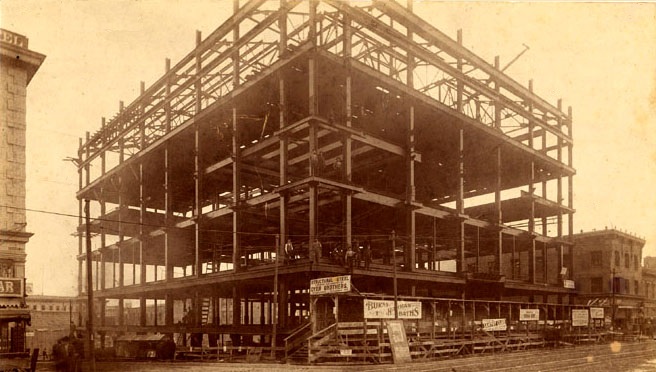
Construction of the second Kearny Street Hall of Justice in the early 1910s. It was built on the footprint of the original Hall (1900-1906), which was destroyed in the great earthquake and fire. The new building contained SF Police headquarters, the municipal courts, and City Prison (booking and intake). Directly behind the Hall (lower left) a new County Jail would also be constructed, separated from the main building by Dunbar Alley. At the time it was often referred to as "the Washington Street Jail".
For some reason, Sheriff Fred Eggers curiously took little public interest in the construction of the new complex and did not use the jail's opening as an opportunity to generate some positive press. On July 26, 1915, 168 prisoners were moved from the Ingleside Jail to the new Washington Street Jail (behind the new Hall of Justice). Forty federal prisoners who had been temporarily housed in the Alameda County Jail were also moved to the new facility in San Francisco.
So there were opportunities to make 1915 a standout year for the Sheriff’s Department and for Eggers to regain a firm hold on his constituency.
But he faced an increasingly big issue at the start of 1915-- the ongoing deterioration of the physical plant of the Ingleside Jails.
The winter and spring of 1914-15 was tough on the old facility with some 300 feet of the jails’ perimeter fence blown down by the winds, and several other major repairs needed for facility security. Eggers request for a budget supplement to get the work done was rejected by the Board of Supervisors who agreed to provide the materials required so long as prisoners were used to do the labor.
But there was a growing resistance by local unions in the City against using inmate labor for civic projects. A year prior, Eggers had engineered several road and street improvement projects in the surrounding Ingleside neighborhood using prisoner labor from the jail, and the negative blowback from the unions put an end to it. An election year would obviously not be the best time to further antagonize organized labor.
On April 20, 1915 five Ingleside prisoners in the jail yard made a break for the biggest hole in the perimeter fence. Richard Pugh, George Riley, and Michael Bradley, in on felony drug charges, escaped “into the Sutro forest” while two others were stopped by shotgun wielding deputies. It was noted that just several weeks prior, two women had escaped from the Ingleside women’s jail through the same convenient hole in the security perimeter fence.
One Louis Kowalski, doing 90 days at Ingleside for robbing church poor boxes, received “leg bail” in the colorful term of the times on June 1st. As Ingleside prisoner escapes began to accelerate at an alarming rate, they also started to become a defining issue in the 1915 Sheriff’s race.
The jail security issue exposed Fred Eggers’ decision-making processes during his term as Sheriff, which seemed almost designed to create problems, specifically media problems. That, coupled with his inability or stubbornness to distance himself from negative issues, created a kind of permanent shadow over his tenure.
It’s also instructive to understand that San Francisco’s newspapers had political angles in their reporting, one paper might be more Republican-leaning, one ULP, another Democratic.
A perfect example is the double column lead headline on page one of the June 17, 1915 SF Examiner.
“COUNTY JAIL DRUG RING PROBE GRIPS AIDS OF SHERIFF”
A Federal investigation by the Collector of Internal Revenue, charged at the time with federal drug enforcement, targeted Assistant Superintendent of Jails Fred H. Classen and George Hetzel, a cook in the jail’s bakery, for smuggling and distributing cocaine, morphine, and other drugs in the Ingleside Jails.
But the next day, in the June 18th edition of the San Francisco Chronicle, a brief story appeared on page 4 with the headline “Tales of Traffic in Drugs Denied”, wherein J.J. Scott of Internal Revenue denied he had any evidence of drug trafficking in the jail. Two different perspectives on the same story.
So an apparent wash, but so many questionable proceedures and semi-legal incidents had occurred under Eggers’ tenure as Sheriff that, as an addendum to the drug story, the Examiner also included an expansive expose with a number of other potentially damaging storylines about the Sheriff’s Department.
Primarily among them was the amazing tale of Fred H. Classen. When we last heard of Classen in 1914, he was the jail’s assistant commissary manager, but now he was variously the “Assistant Superintendent of Jails”, or the “Acting Superintendent of Jails”.
The Examiner devoted a separate news column about Classen who, they discovered, was not employed by the Sheriff’s Department, since the position of “Assistant Superintendent of Jails” had been declared vacant by the Civil Service Commission on February 4, 1915. Repeated attempts by Eggers to have the Civil Service Commission arbitrarily put Classen on that Civil Service list had been flatly denied.
When questioned, Sheriff Eggers stated “I am not paying Classen any money for working out at the County Jail in Ingleside, and neither is the city. Classen is working there out of friendship for me, and he has promised to remain there until his present work is done”; also, “I needed Classen at the county jail because he is the only man who can complete certain work that has started. He is out there now and will remain until this work is finished. I can’t reveal the nature of this work”.
While apparently not paid, Fred Classen and his family lived without cost in an employee apartment on the jail’s grounds, using the commissary for food and supplies.
Before joining the Sheriff’s Department as a guard in 1913, Classen worked as a teamster for Klopstock Brothers mattress makers. On December 27, 1913, Deputy Classen shot and killed David E. Allison near Auburn in Placer County. Allison was serving time in the San Francisco County Jail on a grand larceny conviction when he escaped on December 24, 1913; he apparently had just 90 days left on his sentence. Although a coroner’s jury exonerated Classen in the killing, ruling that it was self-defense, Allison’s family tried and failed to have Classen tried for manslaughter.
Another oddity is that Sheriff Eggers removed his actual Superintendent of Jails, James McQuaide, from the Ingleside Jail and put him behind a desk in the Sheriff’s City Hall office. Because McQuaide’s qualifications had put him on the Civil Service list, his job was protected and Eggers couldn’t fire him. So Classen was the only “superintendent” at the Ingleside Jail and had full authority from Eggers to run the jail.
Another addendum story in the Examiner’s expose was their series of interviews with a number of San Quentin inmates who had been previously held at the Ingleside Jail.
Former Ingleside female prisoner Rose Marks, serving time for “white slavery” at San Quentin, was apparently given extraordinary privileges while at Ingleside. Another San Quentin inmate who had been a “trusty” at Ingleside, Meyer Boag, stated that Marks, accompanied by Sheriff Eggers, famous matron Agnes Wilson, Fred Classen, and others at various times, would take “automobile trips downtown [to San Francisco]” visiting cafes and taverns and “would often be away from the jail all night”.
Sheriff Eggers firmly denied that any of that occurred, stating that people at the jail would have seen him if he had ever driven Rose Marks into the City.
Boag also charged that Fred Classen would often drive prisoners to court dates at the new Hall of Justice in Chinatown, stopping on the way back at the Belvedere Hotel at Geary and Taylor to “get supplies of morphine and cocaine to take back to the County Jail”.
“The county jail was literally full of hop”, Boag told Federal authorities. “It sold for fifty cents a shot, and any prisoner with money could get all he wanted of it. For fifty cents a prisoner could get enough cocaine to cover his thumbnail”.
Unfortunately for Eggers, San Quentin Warden James Johnston also issued a particularly damning statement to the press: “We have more trouble here from prisoners who come from the San Francisco county jail in treating them for addiction to morphine, cocaine, and other drugs than we have with prisoners from any other jail in the State.”
“We know there is someone peddling drugs in the San Francisco jail, but we have no particulars of the men responsible for the traffic.”
Typically, the county jail was not the only thing Sheriff Fred Eggers had difficulty managing. The following day the Examiner printed follow-up statements made by Eggers, Fred Classen, and Rose Marks to its reporters, each quote totally contradicting the others.
It turned out Acting Superintendent of Jails Classen was getting paid by Sheriff Eggers after all. Eggers now told the Examiner, “I pay Classen $50 a month out of my own pocket and the city and county pays for the board of himself, his wife and boy. I have placed him [Classen] in charge of the prison because he is an efficiency expert and has his heart and soul in the work.”
An hour later Classen stated that Eggers was paying him $100 a month to be acting superintendent and that he paid half of the money back to cover board for himself and his family. Where the $50 a month Classen was “paying back” ended up was not detailed. Classen further made it clear he was in no way “an efficiency expert”.
“I had one year’s experience as a guard and jailer and one year in the commissary department before becoming acting superintendent”, Classen stated. “I never made a study of jail government or prison work. All I know about running a jail I have learned since coming here. I did not take the Civil Service examination for superintendent because I knew I could not pass.”
On the Rose Marks issue, Fred Eggers now admitted he had “taken Rose Marks downtown” on at least one occasion but he again denied that he had ever “allowed her to stay away from the jail overnight.”
When the Examiner asked Fred Classen about Rose Marks he stated that “I am absolutely positive that Sheriff Eggers never took Rose Marks down town”; and, “Had Sheriff Eggers accompanied Rose Marks down town I would have been the first to know of it.”
Eggers and Classen also disagreed about the issue of prisoners having money to buy drugs while held at Ingleside. Sheriff Eggers: “How could any prisoner buy drugs when no prisoner is allowed to have no money on his person once he is received at the county jail?”
Acting Superintendent Classen: “Felony prisoners are allowed to keep part of their money so that they can buy things from the grocer…”.
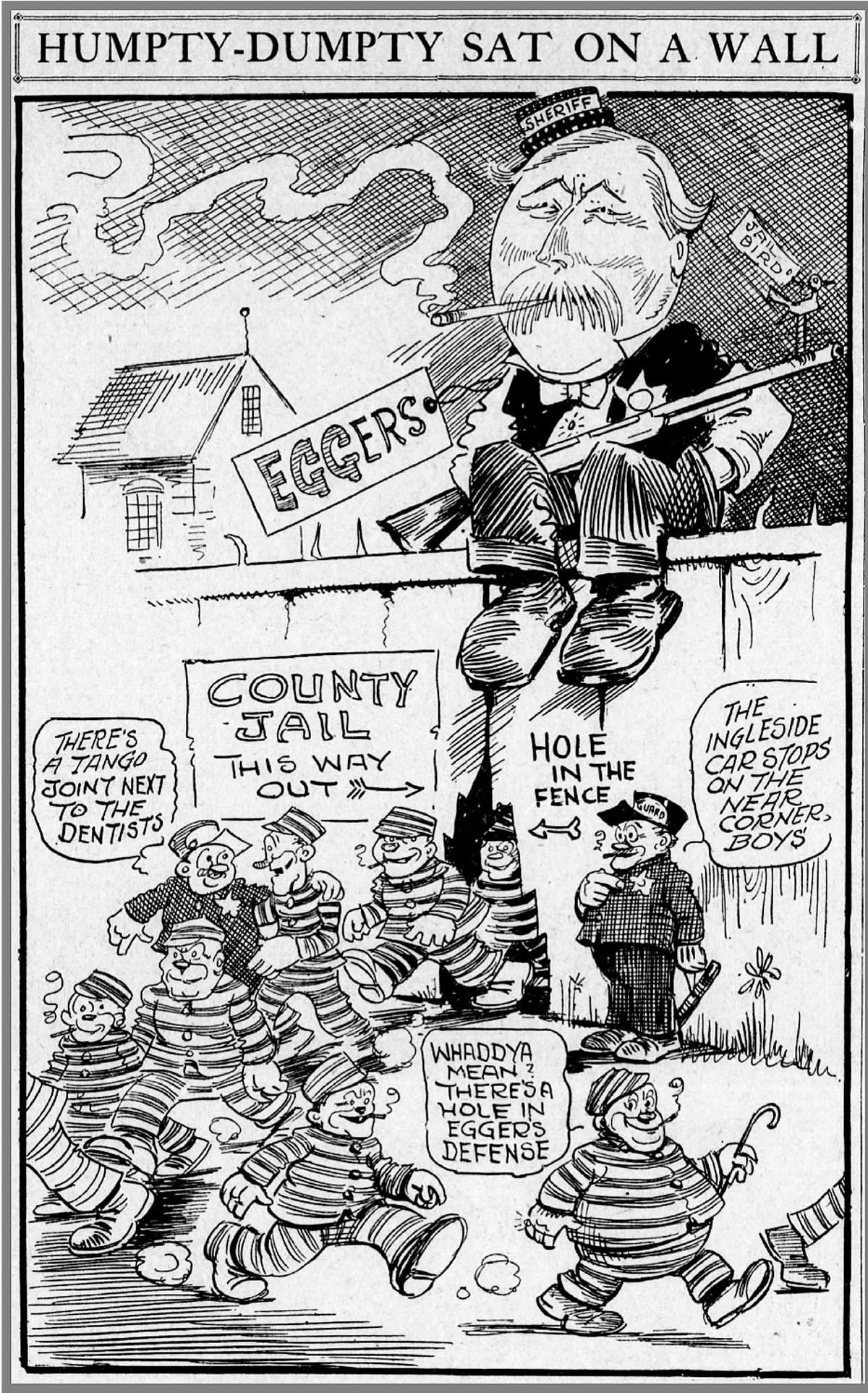
In August 1915 the San Francisco Examiner published this embarrassing editorial cartoon, capturing the state of the San Francisco Sheriff's Department under Sheriff Fred Eggers. Under the caption "Humpty-Dumpty Sat On A Wall", Fred Eggers sits cluelessly atop the Ingleside Jail's perimeter security fence with a shotgun (a "Jail Bird" perched on the barrel), as a conga line of prisoners exits the jail through the now-famous hole in the fence.
A sign on the jail's security fence helpfully states "COUNTY JAIL This Way Out" with an arrow pointing to the hole.
One deputy advises an escaping inmate, "There's a tango joint next to the dentists"; another helpfully points out where the Ingleside streetcar stops. An escaping inmate says "Whaddya mean? There's a hole in Eggers' defense". This cartoon appeared about a month before the September Primary Election for Sheriff.
The overall impression to the voters of San Francisco at the time? That the Sheriff’s Department was a warren of mismanagement, incompetence, corruption and misinformation. But, you might ask, what about prisoner escapes?
Well, on June 22, 1915, five days after the Examiner stories broke, fourteen Ingleside prisoners escaped en mass from the jail, or as the SF Examiner headline described it,
“14 Drug-Mad Men Escape County Jail”
Both Sheriff Eggers and “Acting Superintendent” Fred Classen at first denied to the SF Call that “more than four men had escaped” and that they escaped through the now infamous hole in the Ingleside perimeter fence. Then Sheriff Eggers insisted to the newspapers that only five prisoners escaped, but the press almost immediately found out that Eggers had sent the names of fourteen escapees to the San Francisco Police.
Perhaps just in the nick of time, on July 26, 1915, 168 Ingleside Jail prisoners were transported to the newly completed County Jail on Washington Street just behind the new Kearny Street Hall of Justice. For the SF Examiner it was another opportunity to put in a dig at Eggers and Classen: “Fred Classen, superintendent of the new jail took charge of the removals. Classen has no civil service rating, but is kept in office at the pleasure of Sheriff Eggers.”
The next day, July 27th, it was reported that Eggers had just fired both Undersheriff John Madden and former Undersheriff, now Deputy Sheriff, Oscar Roseberg. Confronted by reporters Sheriff Eggers said, “It’s news to me. Madden is on his vacation, which began Saturday. Rosenberg [sic] is stationed at the detention hospital. The report is not true.”
But employees at the Sheriff’s Department, including John Madden, told members of the press that both Madden and Roseberg had been “slipped the blue envelope” (today’s pink slip) because they were supporting Senator Tom Finn in the upcoming sheriff’s election.
Of course on August 3, 1915 Undersheriff John Madden “resigned” and Fred Classen was appointed by Eggers as his new undersheriff. Oscar Roseberg was fired but managed to get his job back by meeting with Eggers and promising to support his candidacy for sheriff.
In the midst of the increasing problems and ineptitude at the Sheriff’s Department, Senator Thomas Finn announced the opening of his campaign for sheriff headquarters in the Lincoln Building at 5th and Market Streets. And on August 9th Finn became the first candidate to officially file for sheriff, with Fred Eggers filing hours later.
Another prisoner escape would cause Sheriff Eggers columns of negative press in the local papers for months, fully exposing the depth of corruption inside the Sheriff’s Department and seriously damaging his reelection campaign.
On August 13, 1915 Ingleside prisoner Frederick M. Greisheimer escaped from a deputy sheriff while being escorted to an appointment at the dental office of Dr. John Conroy in downtown San Francisco. When confronted by reporters, Sheriff Eggers inexplicably stated, “Well you know we have a big part of the jail fence torn down and the county won’t do nothing about it at all. We have no money to fix up the fence, and so the prisoners—why they just escape.”
Greisheimer, the son of wealthy Chicago parents, had been charged with fraud. The Examiner did not hold back in its criticism of Eggers’ deflective statements referencing the now legendary hole in the Ingleside Jail fence, and the suspicion that the escape was not an accident. “There have been frequent escapes of prisoners from the County Jail recently. Strangely enough nearly all the individuals who escaped had relatives with money.”
The Examiner also noted there had been an astounding sixty escapes from the Ingleside Jail between January and March of 1915.
In the Greisheimer case, Deputy Sheriff Thomas Bell claimed that he had put a handcuff on inmate Greisheimer’s left wrist and held the other cuff as they crossed Powell Street at Eddy. Suddenly an automobile raced toward them and separated the two as Greisheimer somehow slipped the single cuff and then darted across Market Street just as a streetcar came by. Bell contacted Undersheriff Fred Classen about the escape but Classen didn’t report the incident until the next day.
Several aspects of the Greisheimer escape were questionable:
• Dep. Bell did not chase Greisheimer when he made his escape, did not blow his whistle, did not cry out or draw his weapon. No witnesses could be found in midday downtown San Francisco who saw the escape.
• The dental office of Dr. John Conroy was in the Hewes Building at 6th and Market; why Dep. Bell and Greisheimer were blocks away on Powell Street was baffling.
• Dr. Conroy could not be interviewed because he was out of town on August 13th, the day of the escape. He later told the District Attorney he had no appointments, including one with inmate Greisheimer, on that day.
• An acquaintance of Greisheimer’s saw him in the St. Francis Hotel bar the day before the escape, drinking with Dep. Thomas Bell.
• Another friend of Greisheimer’s reported he saw his friend with Dep. Bell and a woman coming out of Tait’s Café on O’Farrell Street on the day of the escape and talked to the trio briefly before Greisheimer left to cash a check.
Assistant Superintendent of Jails Fred Classen told reporters he did not report the escape for 24 hours because he “expected Greisheimer was going to turn himself in”.
Initially Sheriff Eggers suspended Dep. Bell but on August 31, 1915 Eggers conducted a “court hearing” in his City Hall office to determine who was to blame for the escape. At the conclusion of that hearing Eggers ruled that nothing was to blame for the escape except for the use of “old-style” faulty handcuffs, and Dep. Bell was reinstated. Eggers was roundly criticized for naming himself judge and jury in an incident that appeared to be a criminal act rather than a personnel issue.
As for Frederick M. Greisheimer, he was spotted several weeks later on Broadway in New York City dining and drinking with friends. It was reported he was laughing and boasting about how easy it was to escape from jail in San Francisco. Eventually Pinkerton detectives arrested him in New York on September 4th and the San Francisco Grand Jury indicted him in absentia. He was picked up by a San Francisco Police detective and brought to City Prison at the Hall of Justice on October 4th.
Greisheimer later told police and newspaper reporters a completely different story about his escape than the one Dep. Bell related. He said they did go to the dentist’s office, and as Dep. Bell was talking to the receptionist about Dr. Conroy’s absence, Gresheimer made his escape by exiting through a side door before Dep. Bell knew he was gone. The original charges against him faded when the money he defrauded was paid back.
During all of this, on August 28, 1915, Ingleside inmates “Whitey” Best and “Bill” Scott escaped through the now ubiquitous hole in the jail’s perimeter wall. When word of the escape got out to the Examiner, a reporter called Assistant Superintendent Classen at the new Washington Street jail. Classen said he knew nothing of the escapes and suggested the Examiner call the Ingleside Jail. No one at Ingleside had heard of any escapes and they couldn’t even confirm that Best and Scott had ever been prisoners there.
But the Sheriff’s Department did report the escapes to the Police Department.
An editorial in the August 27, 1915 Examiner, a month before the upcoming Primary Election, laid out the case against the reelection of Sheriff Fred Eggers:
"Jail Scandal and The Governor
The County Jail is a scandal and a shame.
Prisoners are allowed to buy drugs as long as they have the money to buy.
Prisoners are permitted to escape, under circumstances which clearly show connivance on the part of jail officials.
Deputies who permit prisoners to escape and make lying reports of the circumstances of the escape are protected from investigation and punishment by the Sheriff.
Just look at the Greisheimer case…."
"...Eggers seems to think he himself is immune—that he is above the law.
Well, he is not.
The Governor of this State can remove a malfeasant Sheriff.
Here are the facts, Governor Johnson—here are the scandalous, shameful facts.
What will you do about them, Governor?
Will you clean San Francisco of this disgrace?"
On the same day the Examiner editorial came out, Board of Supervisors member Ralph McLeran declared he would run for Sheriff as the Democratic candidate against Eggers and Senator Thomas Finn.
An Election Disaster is Seamlessly Joined by Endless Personal Disasters
The Primary Election was held on Tuesday September 28, 1915 and the numbers broke poorly for Fred Eggers in the very first reports from the polls. The combination of the relentless scandals, prisoner escapes, two different recall drives, and the implosion of his private life was just too much for Eggers to overcome. Add to that he was facing a strong candidate in Tom Finn who had won multiple elections to office, including his first term as San Francisco Sheriff in November 1909.
Tom Finn was elected outright in the primary, getting 63,907 votes to Eggers’ total of 19,356—in fact Eggers finished in third place behind Ralph McLeran’s 26,287 vote total. Fred Eggers would never run for public office again.
His defeat in the 1915 Primary began years of legal and money problems for Fred Eggers, starting with thirty of his campaign workers who petitioned the State Labor Commissioner in October to force Eggers to pay them for the services he contracted and owed them. The Labor Commissioner declared if the workers were not paid in full he would prosecute Fred Eggers.
At the same time, Mary Eggers sued him three times before the end of 1915 because he had stopped paying her the $200 a month alimony that was part of their divorce agreement. He lost repeated judgments in court and had to be forced to pay. And this is also when the Eggers family permanently broke apart; his children and their families were not just permanently alienated from Fred and Mary Eggers, none of them ever spoke to each other again.
When Tom Finn took over as Sheriff in January, he had a complete audit done on the Department and immediately found that $897.20 was missing in money paid to Eggers by the U.S. Marshall’s Service for housing federal prisoners. Eggers had taken the money and, after initially feigning ignorance about it, finally had to reimburse the City and County for the full amount. He apparently also removed a number of pieces of furniture from the Ingleside Jail's admin area that had been set up as an apartment for jail matron Agnes Wilson.
In May, Mary Eggers filed a lawsuit against Eggers in Superior Court for $10,000 to recover assets she believed her former husband had hidden during their divorce. In fact, several acres of farm land near Los Gatos, CA were discovered in the name of matron Agnes Wilson which Mary’s attorney suspected was actually purchased by Fred Eggers.
On June 8, 1916 Eggers appeared in court again regarding the unpaid alimony. He told Court Commissioner Thomas Mulvey “I’m broke….”, so the court said they would review his assets. In August Eggers was cited to appear in court after he falsely represented himself as a buyer for a food company and wrote a worthless check for $235.00 to purchase 35 cases of eggs.
More distressing news came on January 5, 1917 when the Eggers’ daughter Marie Freechtle died at the age of 33. No information has been found for the cause of death.
And the seemingly endless financial and legal issues continued. In March 1917 Fred Eggers passed a bad $25 check in Martinez and was summoned to court there; in October he wrote a worthless $40 check to a grocer on Mission Street who swore out a complaint; on October 9th a warrant was issued for Eggers’ arrest for embezzling $95 from a contractor; another warrant for his arrest was issued on March 22, 1918 on a $350 embezzlement charge; on April 4, 1918 another bad check he passed for $10 brought another warrant for his arrest; and the worst case scenario happened with his arrest on April 5th when he couldn’t make the $4,000 bail and was sent to a cell in the County Jail.
On February 4, 1919 yet another arrest warrant was issued for embezzlement from Eggers’ time as Sheriff regarding an $800 bond that was not returned. He was held to answer and again sent to the county jail before he petitioned the court for his release because no evidence was presented. The case was thrown out in July.
A sad report in the November 9, 1919 editions of the SF Examiner and Chronicle newspapers reported that Fred Eggers had been held in the County Jail the past 10 days for not returning another $600 bond he collected when he was Sheriff in a civil case. From his cell, Eggers plaintively petitioned the court to devise some way to gain his freedom. A Sheriff’s bailiff brought Eggers from jail to the courtroom of Judge George H. Cabaniss who suggested that he pay back $25 a month to the complainant until the debt was paid off, which all parties immediately agreed to. At the time Eggers had a part-time job as a coffee and tea salesman.
But there came a poignant moment in the courtroom when Fred Eggers told the Judge that he did not have the $25 to make the first payment to be released from jail. The Judge asked Eggers’ attorney, “Cannot Eggers’ friends arrange payment of this money? Or at least give bond for his release from jail to give him an opportunity to repay it?”
Eggers lawyer replied, “His friends, your honor, have forgotten him”. Judge Cabaniss looked out at the courtroom and said, “Is it possible that this man who was once sheriff of this city and one of the most popular men in San Francisco, has not one friend who will help him in this extremity and keep him out of jail?”
A man named H. A. Glover stood up in the back of the courtroom and said, “I will make the first payment, and here is the money.” Eggers was released and directed to report back to the court next January to determine if the payments have been regularly paid.
The next public mention of former Sheriff Fred Eggers appeared in just one newspaper, the San Francisco Chronicle, on January 22, 1924:
FRED EGGERS, ONCE SHERIFF OF S.F., IS DEAD
The article read, “Fred Eggers, former Sheriff of San Francisco is dead. The body was found yesterday morning in his room at 194 Gough Street by the landlady, Mrs. Augusta Berg.”
“Eggers had not been seen for several days, and Mrs. Berg, unable to get into Eggers’ room, finally used a passkey. By the side of the bed was a bottle half full of whisky.”
“For the past year Eggers had been very despondent, his friends say. Deserted by his family, former political associates and getting too old for active business, he was much disheartened.”
Fred Eggers was 65 years-old. Only two people attended Fred Eggers’ funeral, his sons Arthur and Fred, Jr.
Epilogue: A Continuing Family Legacy of Death
What is more appropriate in the final coda of the Fred Eggers story than additional unexpected death?
On February 20, 1925 a year and a month after her husband died, Mary Eggers passed away at the age of 65. She was listed as being a native of Brinkham, Germany; no cause of death was noted. She willed her $20,000 estate to sons Arthur Eggers and Fred Eggers, Jr., and she gave two diamond earrings to her daughter Etta, who soon found out they were actually glass. A legacy no doubt of her late father’s financial difficulties.
The amateur psychologist would say that Mary Eggers willed herself to live just long enough to see that the man who ruined her life and destroyed her family was dead and buried in the ground. After that, her raison d’etre was gone. Perhaps.
On a particularily bizarre note, in 1928 Fred Eggers’ son Arthur, after working several years for the Pacific Gas & Electric Company, moved to Southern California and got a job with the Los Angeles Sheriff’s Office as a deputy sheriff, eventually assigned as a clerk at the LASO’s Temple City substation. He married Dorothy Armand Lee and over their eighteen-year marriage they adopted her nieces Lorraine and Marie, and made a home at 202 Rosemead Blvd. in Temple City.
On January 2, 1946 a motorist driving along the Rim of the World Highway near Waterman Canyon just north of San Bernardino discovered a dismembered body wrapped in a blanket about forty feet from the side of the roadway. Much later the body was identified as Arthur’s 42-year-old wife, Dorothy Lee Eggers. But shortly after the discovery, Arthur Eggers contacted the LA Sheriff’s Office to report that his wife went missing on December 29th following “an argument about their adopted nieces”.
The body’s head and hands had been cut off and were missing, and it took fully three weeks for the dismembered torso to be identified as Mrs. Eggers. When Eggers, 52, was initially brought to the morgue for a possible identification, he could not identify the remains as his missing wife. But hours later, his eleven-year-old niece Lorraine and Mrs. Eggers’ doctor both positively identified the body.
The San Bernardino Sheriff’s Office, working closely with the LA Sheriff’s Office, quickly started putting the evidence together:
• Arthur Eggers’ initial missing person’s report included a description of his wife so vague and inaccurate that acquaintances pointed out a number of major discrepancies to the authorities;
• After her disappearance, Eggers forged his wife’s name on a pink slip and sold her car, amazingly, to a fellow deputy at the Temple City substation who almost immediately discovered what looked like dried blood drops in the trunk;
• LA deputies searching the couple’s home found a pair of trousers with blood on them, and strands of hair found in their bathtub exactly matched hairs found on the blanket wrapped around her headless torso.
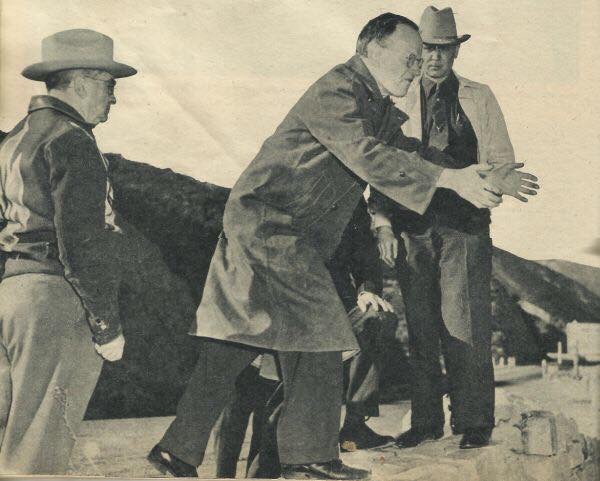
Arthur Eggers with San Bernardino County Sheriff's deputies at the scene where his wife's dismembered body was discovered.
Arthur Eggers was formally arrested by LA County deputies on January 22, 1946. He was immediately questioned by LA Sheriff Eugene Biscailuz and San Bernardino Sheriff Emmett Shay in a county jail interview room, where he told them that his wife had either left home with another man or picked up a hitchhiker who killed her and dismembered her body.
Eggers somehow made it through a five-hour lie detector session conducted by the LA Sheriff’s on January 26th but then fully confessed to the murder on January 27th. His written confession was rife with misleading information as deputies unsuccessfully searched the murder site and the backyard of Eggers’ home for the missing body parts.
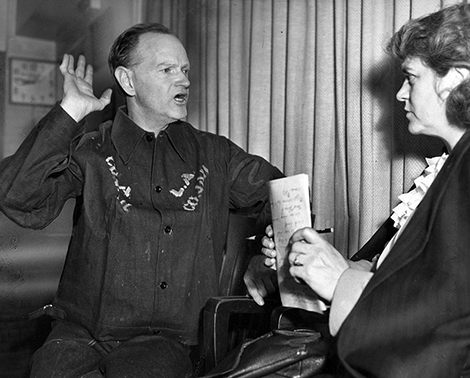
Accused murderer Arthur Eggers being interview by Aggie Underwood of the Los Angeles Herald. Eggers raised his right hand and told her he couldn’t have murdered his wife because “As God is my judge, we had rabbits once and I couldn’t even butcher them”.
On January 30th San Bernardino deputies searching in Santa Anita Canyon north of Arcadia, CA found the .38 caliber revolver he used to kill his wife and the saw (with his initials “AE”) he used to dismember her, wrapped in newspapers inside a paper bag. And with that, the murder trial of Arthur Eggers began.
On May 30, 1946 a jury of ten women and two men completed three days of deliberations and Eggers was found guilty of first-degree murder, which at the time automatically meant death in San Quentin’s gas chamber. When the verdict was announced Eggers turned to his attorney and asked, “How could they? That was not Dorothy’s body”.
The murder of Dorothy Eggers was apparently about her infidelity, but it was really about a deranged, psychopathic husband. Neighbors and friends related to police that Dorothy often entertained male callers at their Temple City home when Arthur Eggers was at work and she freely talked about her sexual escapades.
As LA Sheriff’s investigators pieced it together, his wife’s murder apparently happened when Eggers returned from work at 1AM on December 28, 1945, and saw a man leaving his house. Inside he found his wife naked and she goaded him about having affairs with other men. When she got into the shower he got his revolver and shot her several times, and then cut her head and hands off with a saw in their bathtub. Wrapping her body in a blanket, Eggers drove to the mountains north of San Bernardino where he dumped the torso.
Her appendages were never found.
After a number of appeals, two of which were mounted by Eggers’ sister Etta (who had testified in her parents’ divorce hearing in 1914), and several sanity hearings over the next two-plus years, time finally ran out for Arthur Eggers. He was executed at 10:03 AM on October 5, 1948 in Marin County when cyanide pellets were dropped into a container of sulphuric acid in the San Quentin gas chamber.
Arthur Eggers’ execution for murder occurred just 75 years after his father left Germany to build a new life in America.
---------------------------------------------------------------------
References/sources:
SF Main Library: "NewsBank" San Francisco Chronicle archives; SF Public Library History Center; SF Examiner archives; SF Call archives; UC Riverside CA Digital Newspaper Collection; SF Library: SF City Directories Online; SF Library: "SF Board of Supervisors Journal of Proceedings 1906-1933" collection; Los Angeles Herald; Internet Archive: San Francisco Municipal Records; David Rumsey Historical Map Collection; Library of Congress: Chronicling America; Kevin J. Gilfether; SFSDHistory.com.
